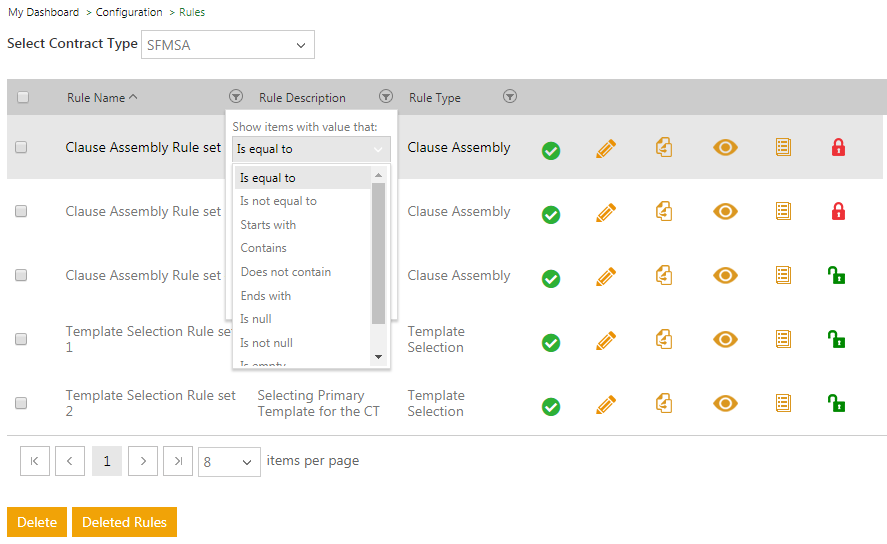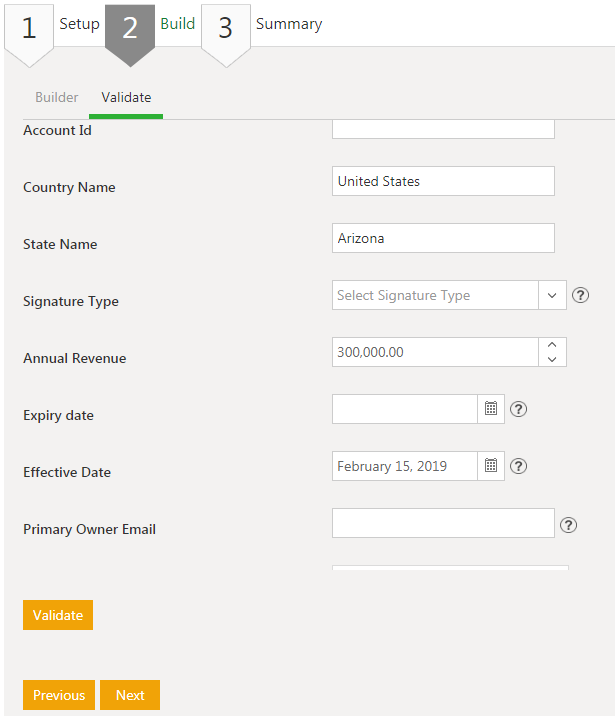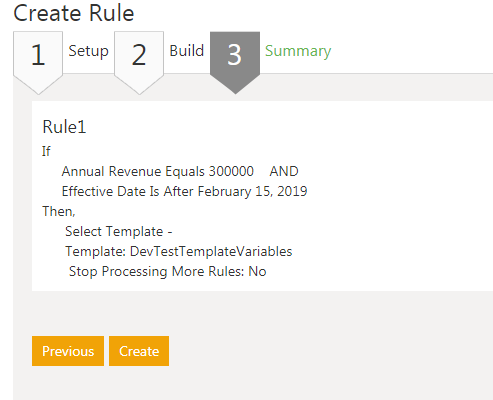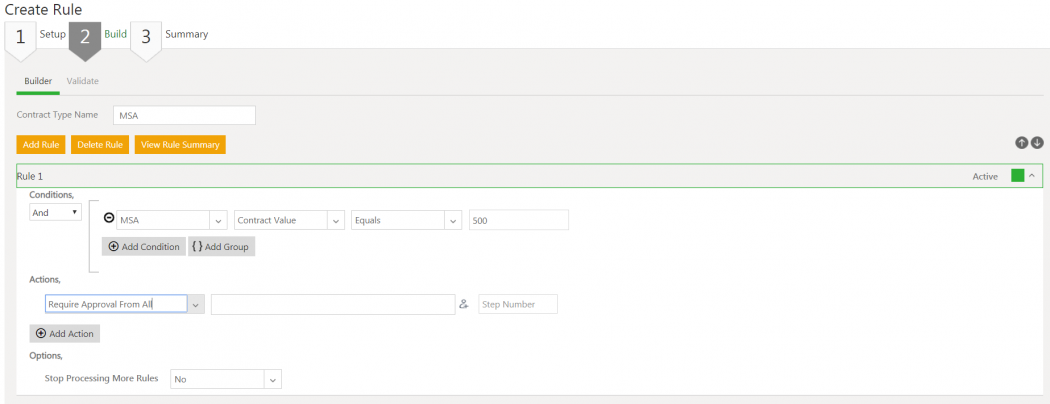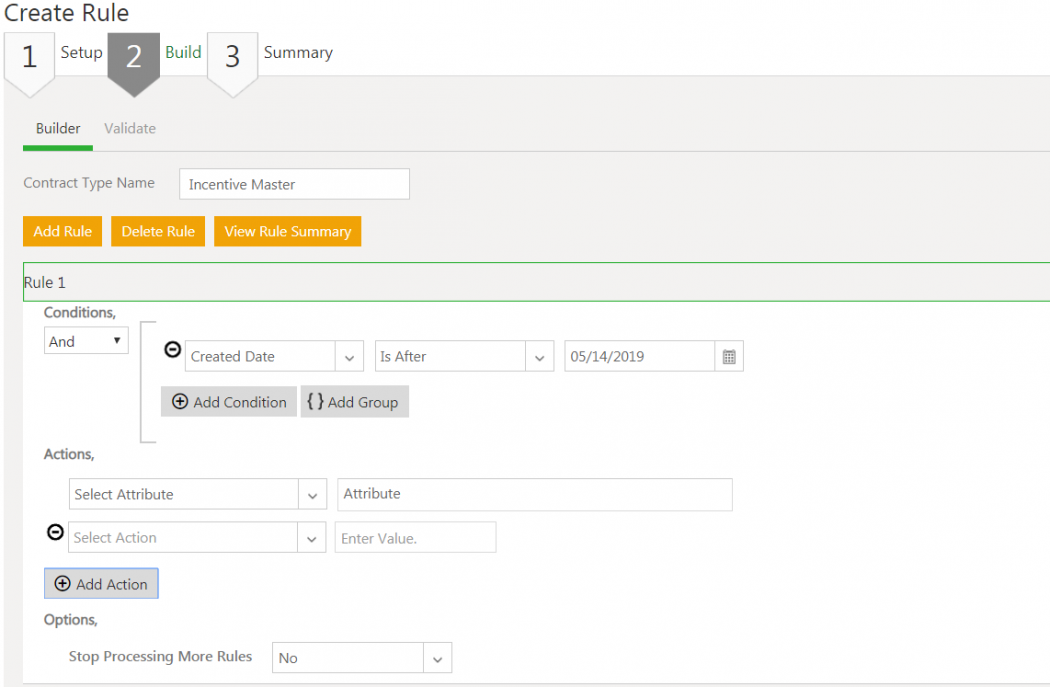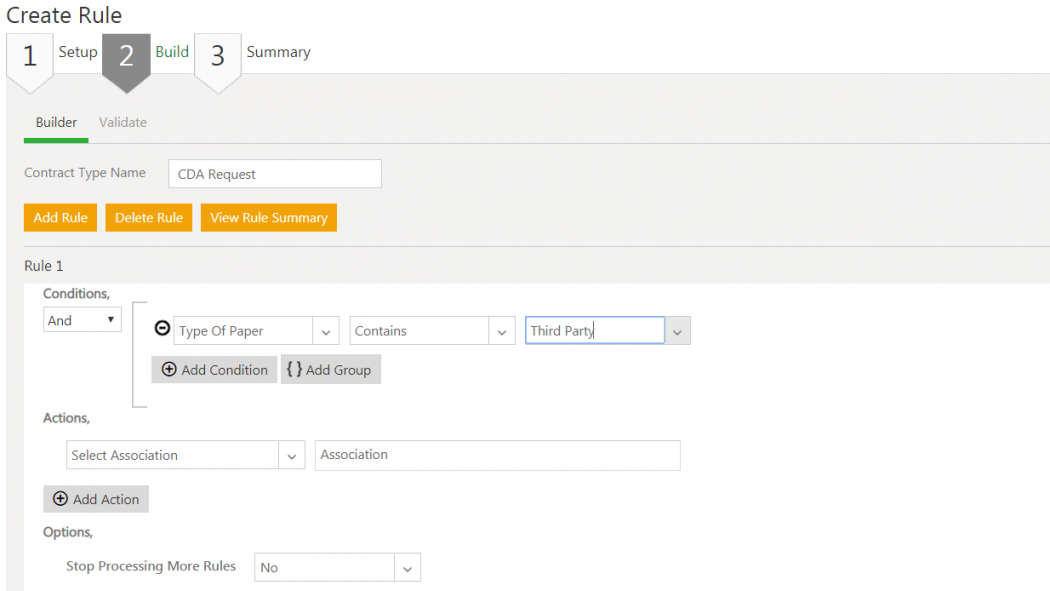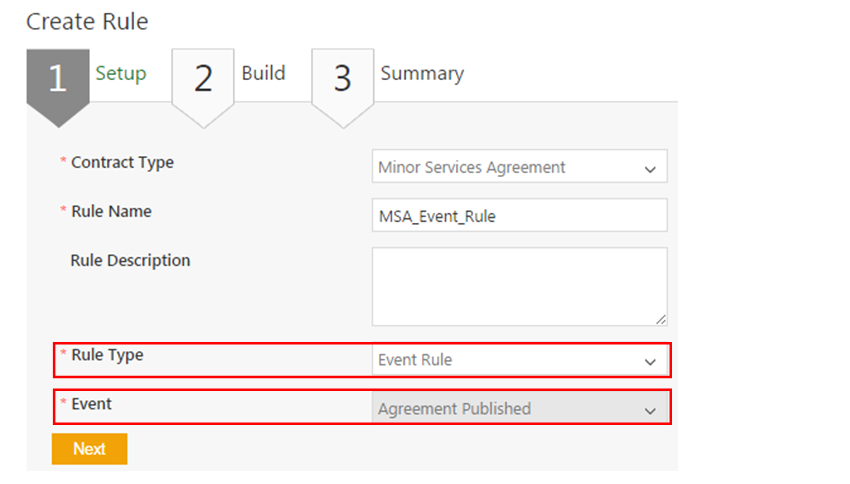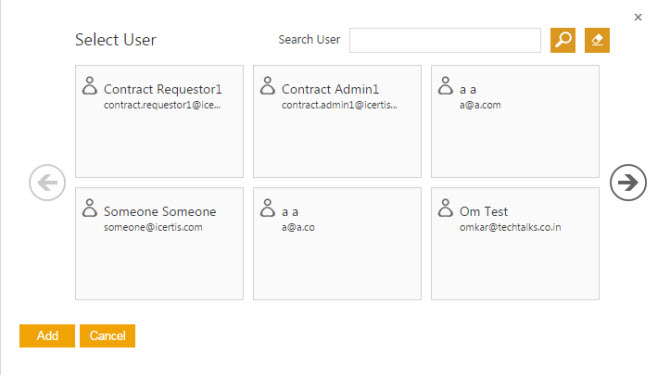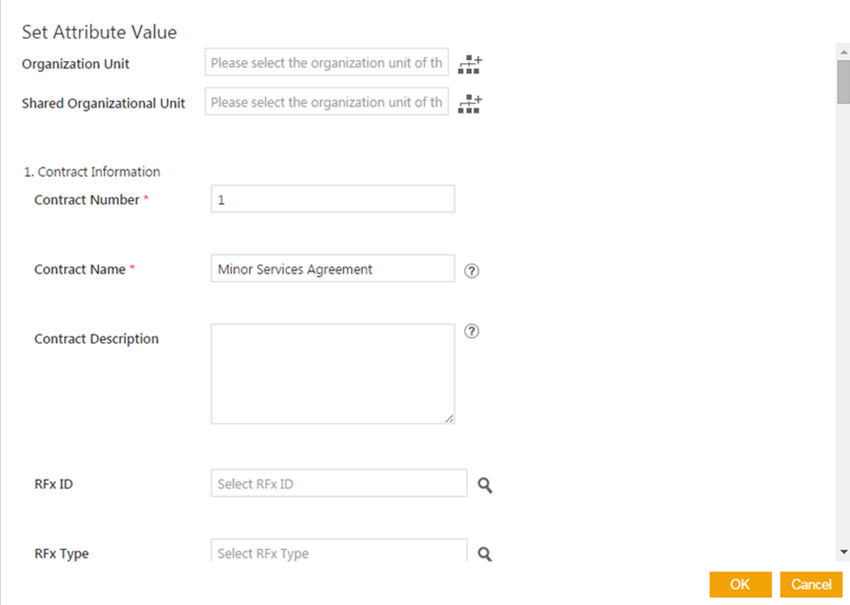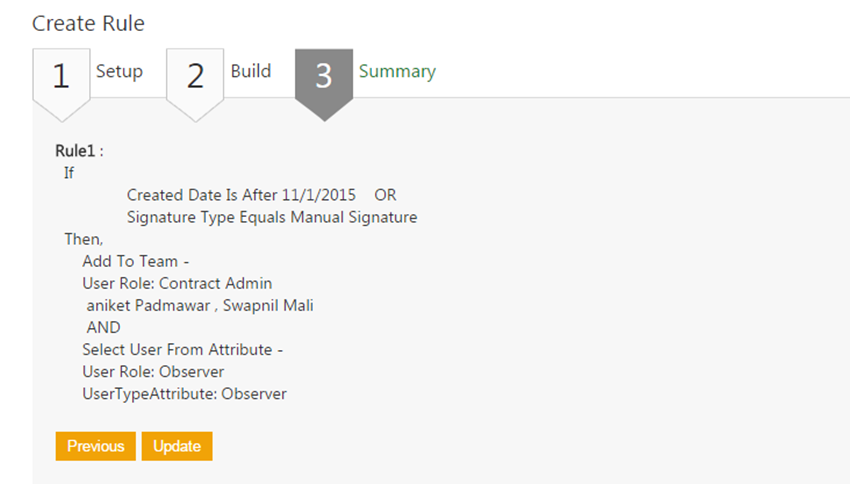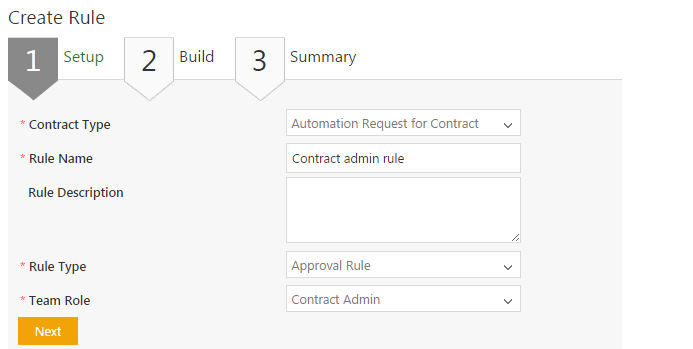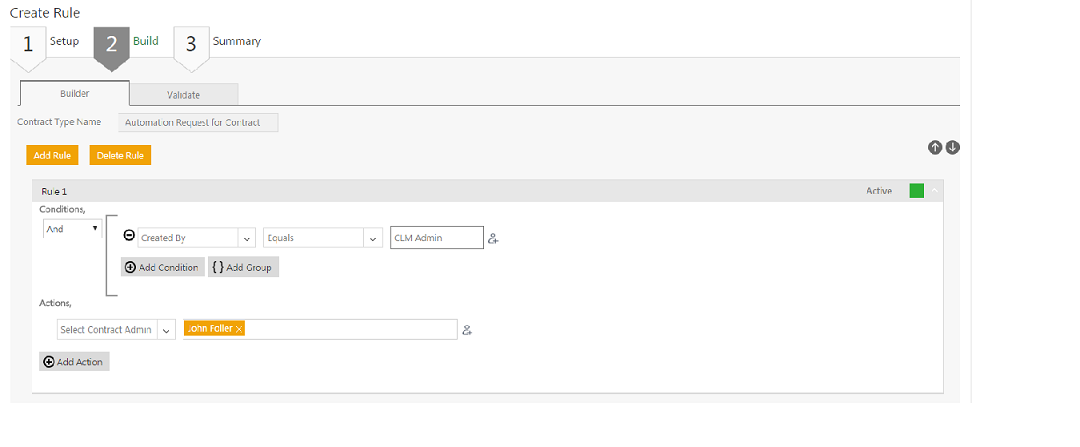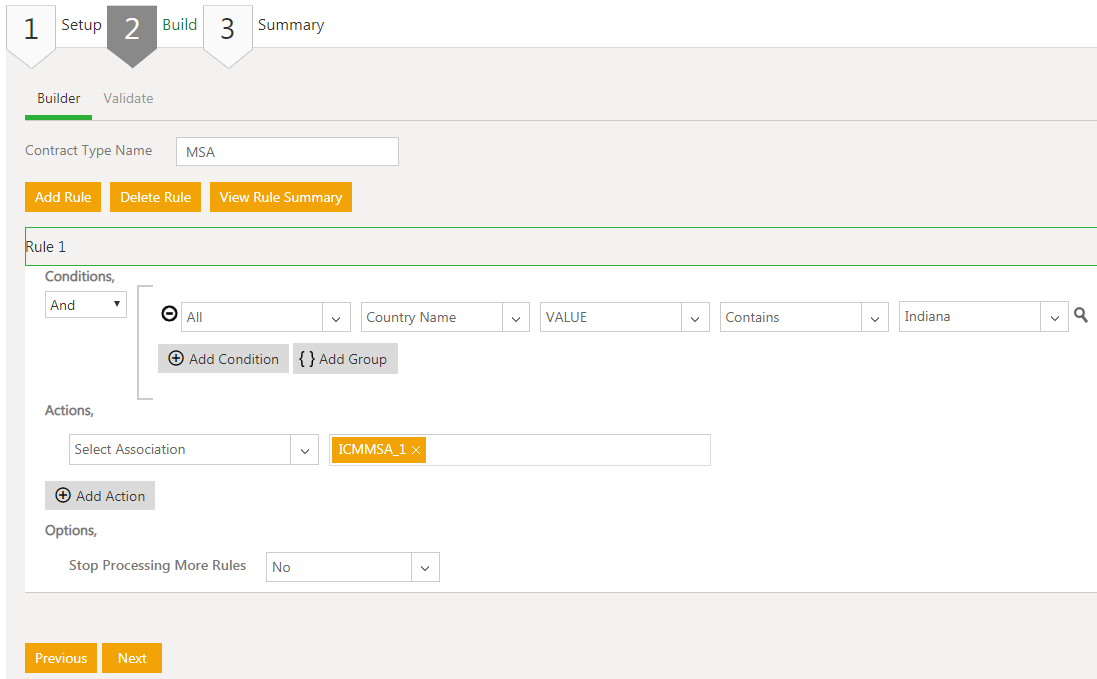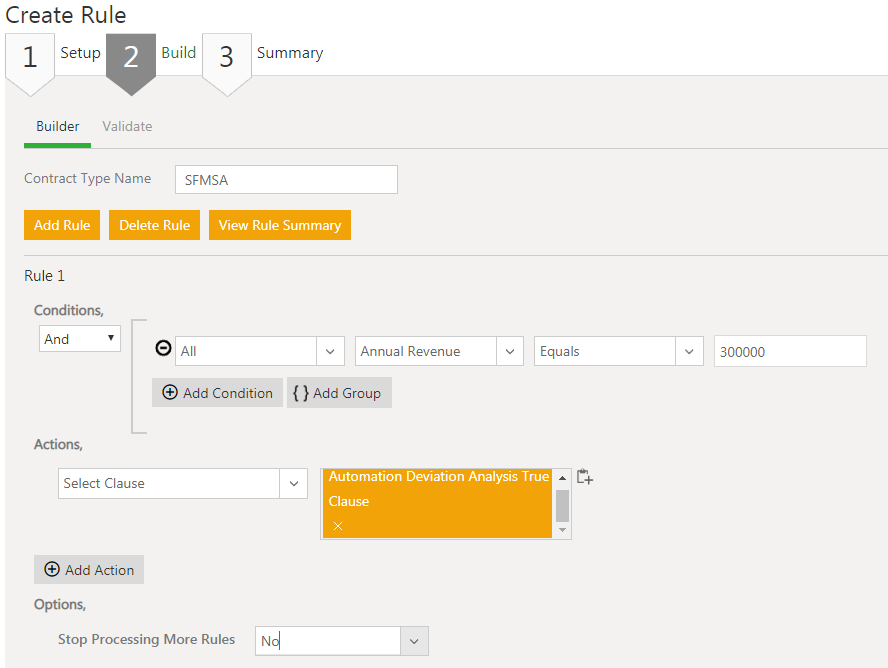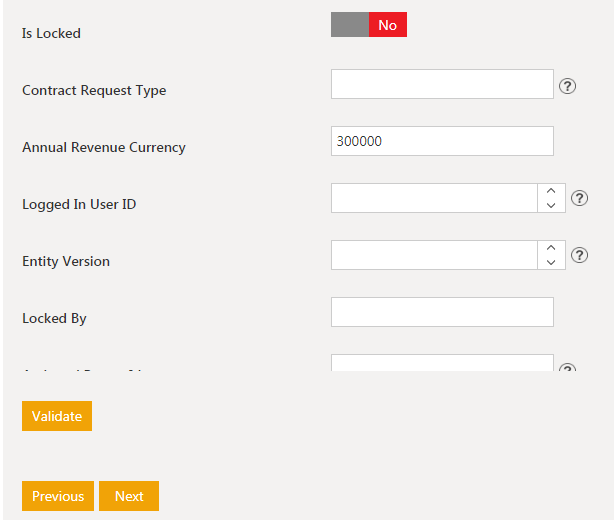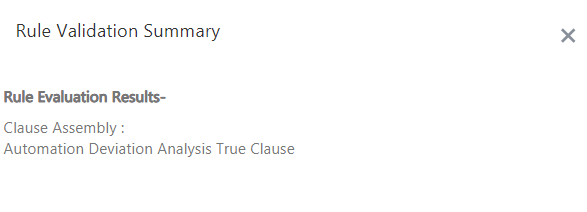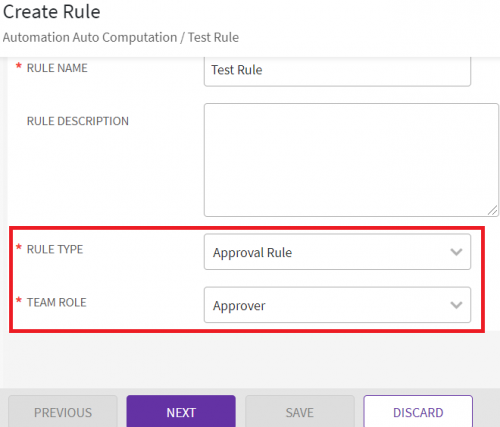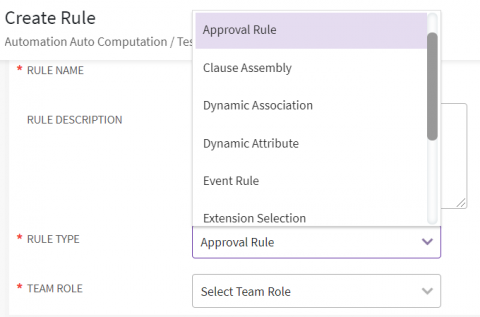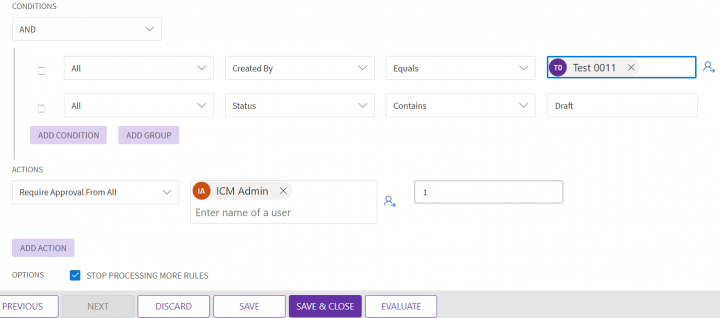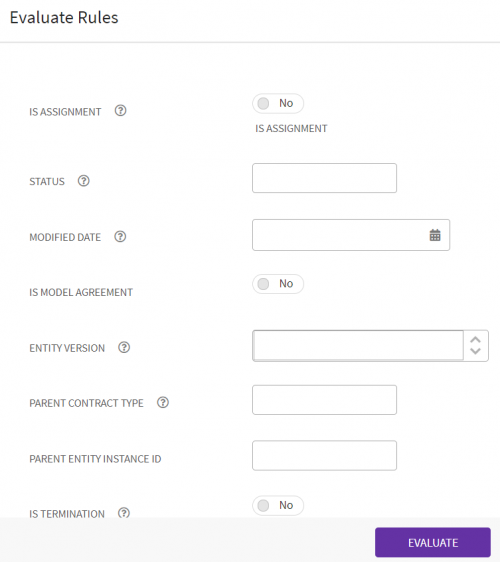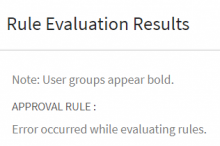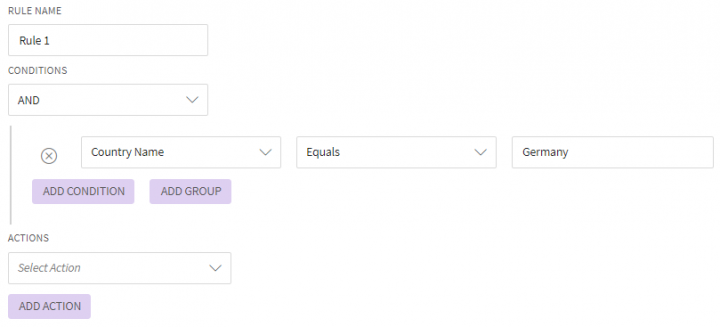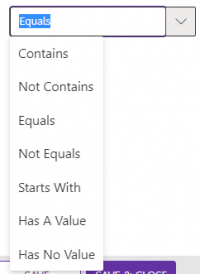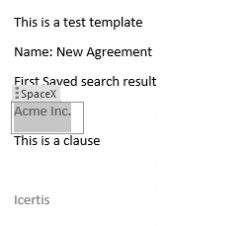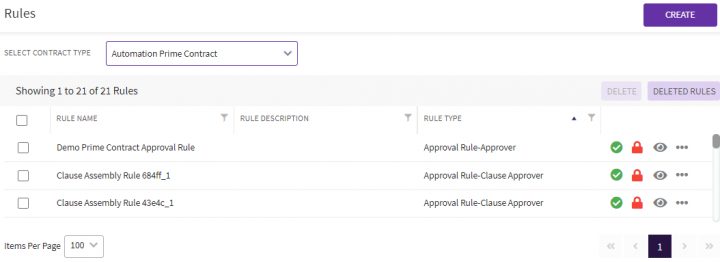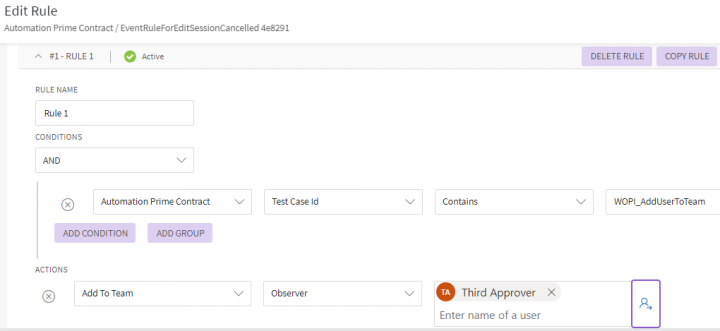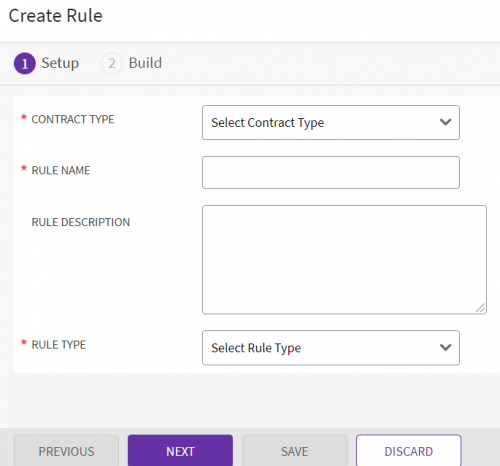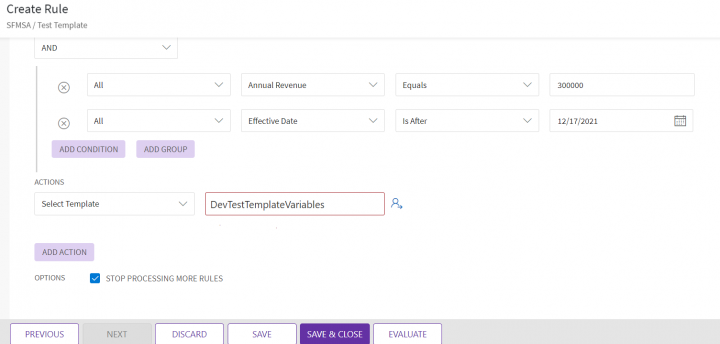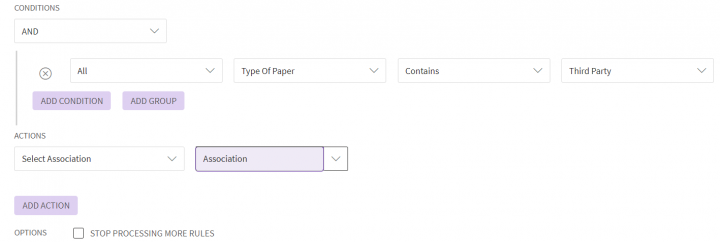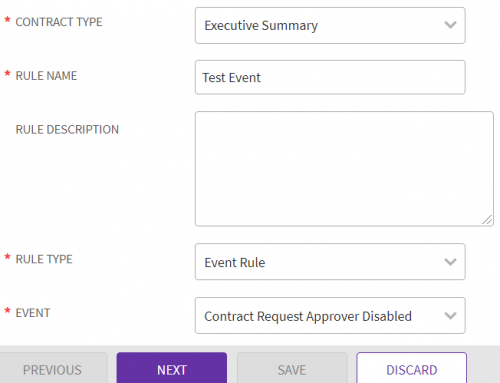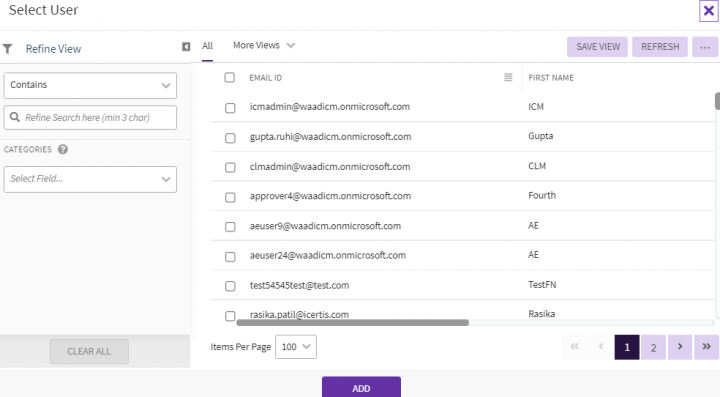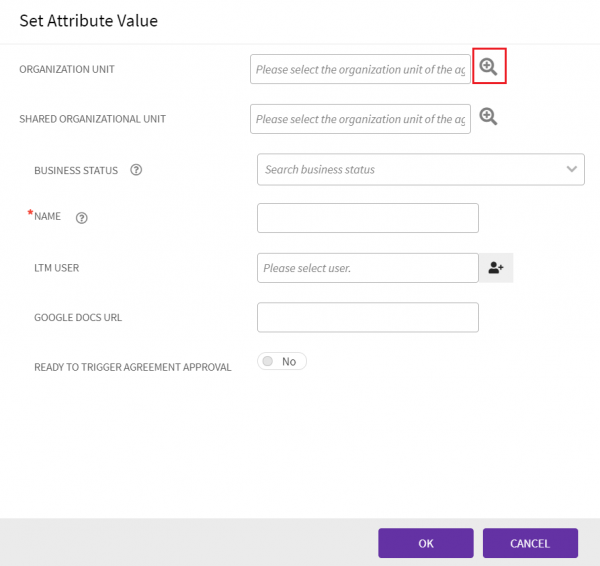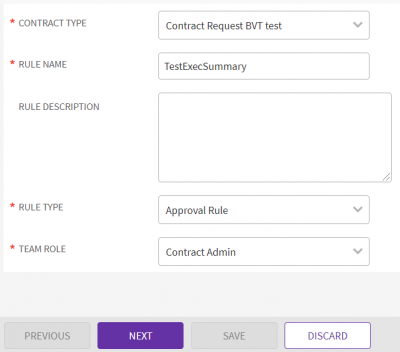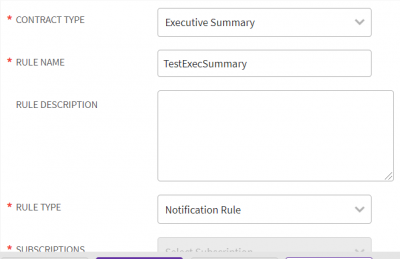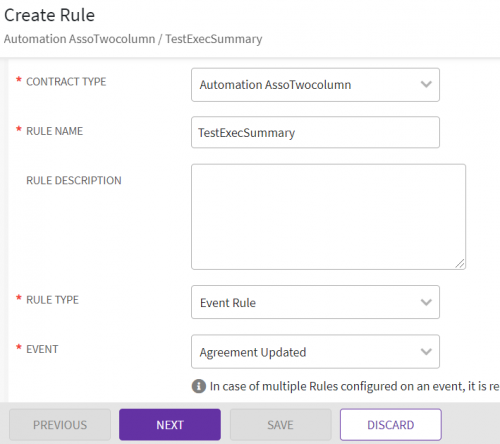| (89 intermediate revisions by 8 users not shown) | |||
| Line 6: | Line 6: | ||
== Create a Rule == | == Create a Rule == | ||
| − | You can create rules to create Requests or Agreements using the | + | You can create rules to create Requests or Agreements using the Rules menu under the Configure tile. For example, you can create a Rule for an Agreement to get the Supporting Documents auto attached at a predefined state. Only users provided with administrative privileges can create Rules. |
Using Rules you can ensure that: | Using Rules you can ensure that: | ||
| Line 13: | Line 13: | ||
* The Agreements/Contracts get executed as required | * The Agreements/Contracts get executed as required | ||
| − | With | + | With ICI, you can create Rules for Contract Types. You can create various types of Rules only for the published Contract Types. |
To create a Rule: | To create a Rule: | ||
| − | 1. '''Click | + | 1. '''Click''' "Configure" tile on the Home page. |
| − | 2. | + | 2. '''Click''' the "Rules" menu under the Configure tile. The Rules page opens. |
| + | <div class="image-green-border">[[File:Configure Rules.png|720px|Configure Rules.png]]</div> | ||
| + | 3. '''Click''' the "Create" button on the Rules page. The Create Rule page opens. | ||
| − | + | The Create Rule page contains the following tabs: | |
| − | + | ||
| − | + | ||
*Setup | *Setup | ||
*Build | *Build | ||
| − | |||
Let us understand each tab one by one. | Let us understand each tab one by one. | ||
| Line 33: | Line 32: | ||
=== Setup === | === Setup === | ||
| − | 1. '''Select''' the Contract Type for which you want to create a Rule in the | + | 1. '''Select''' the "Contract Type" for which you want to create a Rule in the "Contract Type" dropdown list. |
| − | 2. '''Type''' a name of the rule in the | + | 2. '''Type''' a name of the rule in the "Rule Name" box. |
| − | 3. '''Type''' a description for the rule in the | + | 3. '''Type''' a description for the rule in the "Rule Description" box. |
| − | 4. '''Select''' the type of the rule in the | + | 4. '''Select''' the type of the rule in the "Rule Type"'' ''from the "Rule Type" dropdown list. |
| − | + | <div class="image-green-border">[[File:Approval Rule.png|500px|Approval Rule.png]]</div> | |
| − | For each type of a Rule, you need to select an approver role from the | + | For each type of a Rule, you need to select an approver role from the dropdown list. |
*Approval Rule : To build a Rule that defines the conditions in which a specific user will be the approver for the Agreement. | *Approval Rule : To build a Rule that defines the conditions in which a specific user will be the approver for the Agreement. | ||
| − | :If you select the Rule Type as | + | :If you select the Rule Type as "Approval Rule", the "Team Role" field is displayed. You can configure multiple approval rule sets, thus enabling greater flexibility in creating approval rules.<br/> '''Select''' the appropriate role of an approver from the following list of team roles: |
| − | + | <ul style="margin-left: 40px;"> | |
| − | + | <li>Approver</li> | |
| − | + | <li>Deviation Approver</li> | |
| − | + | <li>External Signatory</li> | |
| − | + | <li>Internal Signatory</li> | |
| − | + | <li>Reviewer</li> | |
| − | + | <li>Clause Assembly: To build a Rule that defines the conditions in which a specific clause will open in an Agreement.</li> | |
| − | + | <li>Contract Type Selection: To build a Rule that defines the conditions in which a specific contract type will be selected while creating an Agreement.</li> | |
| − | + | <li>Dynamic Association: To build a Rule that defines the conditions in which a specific Agreement/Associated Document will be selected while creating an Agreement.</li> | |
| − | + | <li>Dynamic Attribute: To build a Rule that defines the conditions in which a specific attribute will open while creating an Agreement.</li> | |
| − | + | <li>Set Attribute Value: Define the value of the attribute.</li> | |
| − | + | <li>Template Selection: To build a Rule that defines the conditions in which a specific template will be selected while creating an Agreement.</li> | |
| − | + | </ul> | |
| − | <div class="note-box">'''Note''': The types of rules that are displayed in the list vary according to the type of the contract you select in the ''Contract Type'' list.</div> | + | <div class="image-green-border" style="margin-left: 40px;">[[File:Rule Types.png|480px|Rule Types.png]]</div> <div class="image-green-border" style="margin-left: 40px;"> </div> <div class="note-box">'''Note''': The types of rules that are displayed in the list vary according to the type of the contract you select in the ''Contract Type'' list.</div> |
| − | 5. '''Click''' | + | 5. '''Click''' "Next". The Build tab opens. |
=== Build === | === Build === | ||
| Line 66: | Line 65: | ||
The Build tab has the following two panes: | The Build tab has the following two panes: | ||
| − | * | + | *Build: You can add a Rule in this pane. |
| − | * | + | *Eavluate: You can type the information that is used to evaluate the Rule you create. |
| − | + | To add a Rule: | |
| − | 1. '''Click''' | + | 1. '''Click''' "Add Rule". |
2. Under Conditions, '''select''' the appropriate condition: | 2. Under Conditions, '''select''' the appropriate condition: | ||
| Line 79: | Line 78: | ||
:*Or: One of the conditions have to be fulfilled to satisfy the rule. | :*Or: One of the conditions have to be fulfilled to satisfy the rule. | ||
| − | 3. Next to the icon , in the | + | 3. Next to the icon, in the "Select Value" field, select the appropriate attribute from the list provided: |
: | : | ||
| Line 91: | Line 90: | ||
:*Type Of Paper | :*Type Of Paper | ||
| − | 4. Based on the attribute you have selected, select appropriate value in the very next | + | 4. Based on the attribute you have selected, select appropriate value in the very next "Select Value" field from the list provided: |
: | : | ||
| Line 98: | Line 97: | ||
:*Not Equals | :*Not Equals | ||
:*Starts With | :*Starts With | ||
| + | :*Greater Than | ||
| + | :*Greater Than or Equals | ||
| + | :*Less Than | ||
| + | :*Less Than or Equals | ||
| + | :*Not Equals | ||
| + | :*Subset Of: the Rule is satisfied where the user wants a Rule to be executed only if the entity field contains a subset of the configured values. This operator is applicable for multi select lookup that supports evaluation of string, number, user, percentage and email data types only. For better understanding, please refer to the subsequent section on Subset Of operator. | ||
:*Has No Value: the Rule is satisfied when no value is selected for the attribute. For example, if the ''Contract value'' is 0, then the Agreement is automatically put on hold (or cancelled). | :*Has No Value: the Rule is satisfied when no value is selected for the attribute. For example, if the ''Contract value'' is 0, then the Agreement is automatically put on hold (or cancelled). | ||
| − | :*Has A Value: the Rule is satisfied as long as the attribute has some value. For example, | + | :*Has A Value: the Rule is satisfied as long as the attribute has some value. This includes all Data Types and system-defined Attributes such that Rules can be set up for an Attribute having any value. For example, you want to set up a Rule so that an Approver John Doe should approve the Contract if a discount is applicable to it, irrespective of the value of the discount. Then, user can add a Rule using the Has A Value condition such that John Doe is added as an Approver if the discount has a value of 5%, 10% or whatever value is desired. |
| − | :*Not | + | :*Not Contains: the Rule is satisfied when the value of an attribute is blank. For example, if the ''City'' value is blank, a Rule will be triggered, which will default the name of the city to the city of the head office. |
| − | Once selected, '''enter''' an appropriate value in the | + | Once selected, '''enter''' an appropriate value in the "Enter Value" field. |
| − | 5. '''Click''' the Add icon to add | + | 5. '''Click''' the Add icon to add a condition. |
| − | 6. '''Click''' | + | 6. '''Click''' "Add Condition" button to add another group of conditions. When you add a group, all the conditions in the group should be fulfilled to satisfy the rule. |
| − | 7. Under | + | 7. Under "Actions", in the "Select Action" list, select the desired action. |
:For example: | :For example: | ||
| Line 115: | Line 120: | ||
:*Select User From Attribute | :*Select User From Attribute | ||
| − | 8. '''Select''' actions consequent to the conditions you have set, and then enter their value. For example, under | + | 8. '''Select''' actions consequent to the conditions you have set, and then enter their value. For example, under "Conditions", if you select "Created By Equals x User", then under "Actions" you may select "Require Approval From Any", and then type appropriate value. that is if the user x creates an Agreement using the selected Contract Type, then it will require approval from any of the selected approvers. |
| − | 9. '''Type''' the number of approvers required in the | + | 9. '''Type''' the number of approvers required in the "Minimum Approvers" text box, and then '''type''' appropriate "Step Number" for those Approvers. The Agreement approval process flows sequentially according to the Step Number of the approver. When Approvers are defined based on the user attribute, the Administrator can specify a minimum number of approvals required for an Agreement before it can move to the next step in the workflow. As a result, not all Approvers configured for the specific user attribute are required to approve the Agreement. |
| − | <div class="image-green-border">[[File: | + | <div class="image-green-border">[[File:Create Rule Conditions.png|720px|Create Rule Conditions.png]]</div> |
| − | === | + | === Evaluate === |
| − | Based on the | + | Based on the "Contract Type" you select in the "Setup" section, relevant attributes are displayed in the "Evaluate" pane. The information you type in this pane evaluates the Rule that you create. |
| − | '''Click''' | + | '''Click''' "Next". The "Summary" tab opens. |
| − | === | + | === Has A Value Condition === |
| − | + | The "Has A Value" condition has been enhanced to include all Data Types and system-defined Attributes such that Rules can be set up for an Attribute having any value. | |
| − | The ''Rule created | + | Let's apply "Has A Value" condition on "Agreement Code" Attribute of Contract Type "Teaming Agreement" having "Auto" Data Type. |
| + | |||
| + | 1. '''Click''' "Configure" tile on the Home page. | ||
| + | |||
| + | 2. '''Click''' the "Rules" menu under the Configure tile. The Rules page opens. | ||
| + | |||
| + | 3. '''Select''' the "Contract Type" from the "Contract Type" dropdown list. | ||
| + | |||
| + | 4. '''Type''' a name of the rule in the "Rule Name" box. | ||
| + | |||
| + | 5. '''Type''' a description for the rule in the "Rule Description" box. | ||
| + | |||
| + | 6. '''Select''' the type of the rule in the "Rule Type"'' ''from the "Rule Type" dropdown list. For example, Approval Rule. | ||
| + | |||
| + | 7. '''Select '''the role for team member from the "Team Role" dropdown list. For example, Approver. | ||
| + | <div class="image-green-border">[[File:Approval Rule.png|500px|Approval Rule.png]]</div> | ||
| + | 7. '''Click '''"Next". The Build tab of Create Rule page opens. | ||
| + | |||
| + | 8. '''Select '''the "Attribute" value (system or user defined) for which you want to apply the condition from the "Select Value" dropdown list. For example, Agreement Code. | ||
| + | |||
| + | 9. '''Select '''the "Has A Value" condition from the Operators dropdown list. | ||
| + | |||
| + | 10. '''Select''' the action that you want to take from the "Actions" dropdown list. For example, Require Approval From All. | ||
| + | |||
| + | 11. '''Select '''a user from the "Select User" dropdown list. | ||
| + | |||
| + | 12. '''Select '''a corresponding "Step Number" for the selected User. | ||
| + | |||
| + | 13. '''Click '''"Add Action" if you want to add another condition. | ||
| + | |||
| + | 14. '''Select''' "Stop Processing More Rules" checkbox. | ||
| + | <div class="note-box">'''Note:''' The Stop Processing More Rules option when set to Yes allows you to stop evaluating further Rules for the Ruleset.</div> | ||
| + | 17. '''Click '''the "Evaluate" button to evaluate the Rule. For example, enter code in the Agreement Code field as per the defined Rule. | ||
| + | <div class="image-green-border">[[File:Evaluate Rules1.png|500px|Evaluate Rules1.png]]</div> <div class="image-green-border"> </div> <div class="image-green-border">18. '''Click '''the "Evaluate" button on the Evaluate Rules pane to evaluate the Rule you created. The Rule Validation Summary window opens.</div> <div class="image-green-border"><br/> ''[[File:Rule Evaluation Results.png|220px|Rule Evaluation Results.png]]''</div> <div class="image-green-border"> </div> | ||
| + | === Subset Of Operator === | ||
| + | |||
| + | With a "Subset of" operator, a user can configure conditions for power sets (i.e. cases where the user wants a Rule to be executed only if the entity field contains a subset of the configured values). This new operator, "Subset of", which is applicable to only multiselect lookup supports evaluation of string, number, user, percentage and email data types only. Let's consider an example to define a "Template Selection" Rule with the "Subset Of" operator using "Number" Data Type. | ||
| + | |||
| + | 1. '''Click''' "Configure" tile on the Home page. | ||
| + | |||
| + | 2. '''Click''' the "Rules" menu under the Configure tile. The Rules page opens. | ||
| + | |||
| + | 3. '''Select''' the "Contract Type" from the "Contract Type" dropdown list. | ||
| + | |||
| + | 4. '''Type''' a name of the rule in the "Rule Name" box. | ||
| + | |||
| + | 5. '''Type''' a description for the rule in the "Rule Description" box. | ||
| + | |||
| + | 6. '''Select''' the type of the rule in the "Rule Type"'' ''from the "Rule Type" dropdown list. | ||
| + | |||
| + | 7. '''Select '''the role for team member from the "Team Role" dropdown list. | ||
| + | |||
| + | 8. '''Click '''"Next". The Build tab'' ''opens''.'' | ||
| + | |||
| + | 9.'' '''''Click '''"Add Rule" in the Build'' ''tab. | ||
| + | |||
| + | *'''Select '''the Contract Type from the dropdown list, which helps you to select the Attribute set for which you want to create the Rule. For example, "Teaming Agreement". | ||
| + | *'''Select '''the Multi-Select Lookup Attribute for which you want to apply the condition from the Select Value dropdown list. For example, RAP_Supplier Name. RAP_Supplier Name is an Attribute of Teaming Agreement with Number Data Type having Is Multi Select flag enabled. | ||
| + | *'''Select "'''VALUE" condition from the dropdown list. | ||
| + | *'''Select''' the "Subset of Operator" from the dropdown list. | ||
| + | *'''Select''' the options where you want to apply the "Subset Of" operator. For example, Mac & Jhonson and RAP_Supplier1. This means the Template Selection Rule will only trigger when a RAP_Supplier Name field has either of Mac & Jhonson and RAP_Supplier1 or both names. | ||
| + | <div class="note-box">'''Note: '''The Subset Of operator is available only for the Multi Select Lookup Attribute.</div> | ||
| + | 10. '''Select '''the Action that you want to take from the "Actions" dropdown list. For example, Select Template. | ||
| + | |||
| + | 11. '''Select '''the Template to be available when the defined conditions are met. For example, Template approval verification and Clause assembly verification perf. | ||
| + | |||
| + | 12. '''Select''' the "Stop Processing More Rules" checkbox. | ||
| + | <div class="note-box">'''Note:''' The Stop Processing More Rules option when setting to ''Yes'' allows you to stop evaluating further Rules for the Ruleset. </div> | ||
| + | 13. '''Click '''the "Evaluate" button to evaluate the Rule. | ||
| + | |||
| + | 14. '''Enter''' the required value as per the defined Rule. For example, '''enter''' Mac & Jhonson and RAP_Supplier1 in the RAP_Supplier Name field. | ||
| + | |||
| + | 15. '''Click '''the "Evaluate" button on the Evalute Rules pane. The Rules Evaluation Results window opens. | ||
<div class="note-box">'''Note''': For mutually exclusive rules, you now have an option to stop processing subsequent rules.</div> | <div class="note-box">'''Note''': For mutually exclusive rules, you now have an option to stop processing subsequent rules.</div> | ||
=== Creating Count Based Rules === | === Creating Count Based Rules === | ||
| − | + | ICI allows you to set the Rules based on the total number of selected values (count of selected values) in multi-select type Attributes. | |
| − | + | ||
| − | + | ||
| − | + | For example, for an attribute Country Name, if the user selects more than two countries i.e. Count is Greater Than 2, then the Agreement can be sent for approval to the selected users. <could not locate the Count option for attribute "Country Name">. | |
| − | <div class="image-green-border">[[File: | + | <div class="image-green-border">[[File:Create Rule X1.PNG|720px|Create Rule X1.PNG]]</div> |
| − | | + | The supported operators are: "Contains", "Not Contains", "Equals", "Not Equals", "Starts With", "Has a Value", and "Has No Value", |
| − | <div class="image-green-border">[[File: | + | <div class="image-green-border">[[File:Create Rule X2.PNG|200px|Create Rule X2.PNG]]</div> |
== Using Masterdata Value options in Rules Actions == | == Using Masterdata Value options in Rules Actions == | ||
| Line 146: | Line 221: | ||
*You can define Rules on Masterdata columns when lookup to the Masterdata is added as an Agreement Attribute. You can configure the list of Lookup and/or Cascade Attributes as conditions for Agreement or Contract Request Contract Types Rules, thus improving flexibility in Rules. For example, you may have a supplier Masterdata being referred in MSA Agreement Type via Supplier Country Name lookup. But, there may be scenarios where Rules are required to be configured on basis of Supplier City Name and is not available as an Attribute in the Agreement, which is now made possible. | *You can define Rules on Masterdata columns when lookup to the Masterdata is added as an Agreement Attribute. You can configure the list of Lookup and/or Cascade Attributes as conditions for Agreement or Contract Request Contract Types Rules, thus improving flexibility in Rules. For example, you may have a supplier Masterdata being referred in MSA Agreement Type via Supplier Country Name lookup. But, there may be scenarios where Rules are required to be configured on basis of Supplier City Name and is not available as an Attribute in the Agreement, which is now made possible. | ||
| − | * | + | *ICI also supports Masterdata value options in the Actions section of Rules, so that you can define Rules without having the Cascade Attribute on the Contract Type where the Rule is being written. For example, if multiple signatories are part of a Lookup Masterdata record, we can now define the Rule (such as – Select User From Attribute) on the Masterdata record itself and use them in the Rule directly, instead of defining Cascade Lookup Attributes in the Agreement. This drastically reduces the time and effort to create and maintain a large number of Attributes for Agreement Contract Types. |
| − | <div class="image-green-border">[[File:Rule | + | <div class="image-green-border">[[File:Master Agreement Rule.png|720px|Master Agreement Rule.png]]</div> <div class="image-green-border"> </div> |
=== Create Rules for Multi-party Agreements === | === Create Rules for Multi-party Agreements === | ||
| − | Rules can be written for individual attributes of an Association (as done for parent Contract Types). All attributes for Associations are available for the given Rule conditions. You can search selected values on an Agreement or an Associated Document. Depending on the type of the attribute, standard operators are applicable. For example, | + | Rules can be written for individual attributes of an Association (as done for parent Contract Types). All attributes for Associations are available for the given Rule conditions. You can search selected values on an Agreement or an Associated Document. Depending on the type of the attribute, standard operators are applicable. For example, "Contains", "Starts With", "Equals", "Greater Than", and so on. |
| − | Rules can also accommodate the count of the Associations so that you can add Clauses based on the count of the Associations. If you | + | Rules can also accommodate the count of the Associations so that you can add Clauses based on the count of the Associations. If you "Select All" or "Select Any", there is no need to specify the count of the Associations to satisfy the rule. However, when selecting the option "Select Count", you need to specify the number of Associations, irrespective of the attribute value, that should meet the condition and satisfy the Rule. This rule applies to any type of Association, parent/child or peer. |
However, if the attribute belongs to an Association, the following additional filter Conditions are available for all the Rules: | However, if the attribute belongs to an Association, the following additional filter Conditions are available for all the Rules: | ||
| − | * | + | *Select All: If all the Associations satisfy the condition |
| − | * | + | *Select Any: If any Association satisfies the condition |
| − | * | + | *Select Count: If the number of Associations specified satisfy the condition |
| − | <div class="image-green-border">[[File: | + | <div class="image-green-border">[[File:Multi-party Rule X5.PNG|840px|Multi-party Rule X5.PNG]]</div> |
For a multi-division Agreement, you can write Rules based on individual instances of the multi-value attributes. | For a multi-division Agreement, you can write Rules based on individual instances of the multi-value attributes. | ||
| − | Rules can accommodate the count of the Associations, besides | + | Rules can accommodate the count of the Associations, besides "Select All" and "Select Any" Conditions. If you "Select All" or "Select Any", there is no need to specify the count of the Associations to satisfy the Rule. However, when you "Select Count", then you need to specify the number of Associations, irrespective of the attribute value, that should meet the condition and satisfy the Rule. |
| − | <div class="image-green-border">[[File: | + | <div class="image-green-border">[[File:Multi Party Rule.png|720px]]</div> |
If you have more than two Associations, the values of the attributes are irrelevant. The count of the Association takes precedence. | If you have more than two Associations, the values of the attributes are irrelevant. The count of the Association takes precedence. | ||
| Line 176: | Line 251: | ||
2. After the content control tag is entered, the value of the associated instances metadata is placed in the content control. | 2. After the content control tag is entered, the value of the associated instances metadata is placed in the content control. | ||
| − | 3. If the value taken from the Agreement above was | + | 3. If the value taken from the Agreement above was "Acme Inc." for the first instance, then it will be displayed as shown in the figure after Edit or Publish. |
| − | + | <div class="image-green-border">[[File:Rules - Changes in Document Assembly.png|250px|Create a Rule - Changes in Document Assembly will replace tags with metadata value]]</div> | |
| − | + | ||
| − | <div class="image-green-border">[[File:Rules - Changes in Document Assembly.png|Create a Rule - Changes in Document Assembly will replace tags with metadata value]]</div> | + | |
== View or Edit a Rule == | == View or Edit a Rule == | ||
| − | In | + | In ICI, you can View, Edit, Copy, Activate, Deactivate, or Lock a Rule. Follow these steps to View or Edit a Rule: |
| − | 1. '''Click ' | + | 1. '''Click''' "Configure" tile on the Home page. |
| − | 2. '''Click '''''< | + | 2. '''Click''' the "Rules" menu under the Configure tile. The Rules page opens. |
| + | <div class="image-green-border">3. '''Select''' the appropriate Contract Type from the "Select Contract Type" dropdown list. A list of Rules that are created for the selected Contract Type is displayed. You can use the filters provided in each column to find the desired Rule.</div> <div class="image-green-border"> </div> <div class="image-green-border">[[File:View Rule X5.PNG|720px|View Rule X5.PNG]]</div> | ||
| + | 4. '''Select''' the check box next to the Rule name, and then '''click''' the "Delete" button to delete the Rule. You can also select multiple rules, and '''click''' the "Delete Rules". | ||
| + | <div class="image-green-border">[[File:Delete Rule X5.PNG|720px|Delete Rule X5.PNG]]</div> | ||
| + | You can also perform the following actions on a particular rule: | ||
| + | <div class="image-green-border">[[File:Actions Rule X5.PNG|720px|Actions Rule X5.PNG]]</div> | ||
| + | *Activate/Deactivate icon''': '''To activate or deactivate a Rule. The Rule will no more be applicable to the associated Contract Type. | ||
| + | *Edit: To edit the selected Rule. On the Edit Rule page, edit the appropriate information. and '''click '''Update. Editing the Rule automatically locks it. When updating the Rule, there is a checkbox option (default – unchecked) on the Edit Rule page, indicating that the Rule will be unlocked on update. If checked, the Rule stays locked for the other users. After editing the Rule, you can evaluate and later Save & Close it in order to lock the rule. | ||
| + | <div class="image-green-border">[[File:Edit Rule X5.PNG|720px|Edit Rule X5.PNG]]</div> | ||
| + | *Copy: To copy the selected Rule for another Contract Type. In the "Copy Rule" dialog box, '''select''' Contract Type, '''type''' the Rule name and then '''click''' "Copy". The Rule becomes applicable for another Contract Type that you selected. | ||
| + | *View: To view the details of the selected Rule. The Rule Summary page opens where you can view the Rule details of the selected Rule. | ||
| + | *Audit Log: To view the Audit Logs of the Rule. Audit Logs screen contains the complete history of the specific Rule. Here, you can track all the changes made to the Rules, including the deletion. Editing a rule set inside a Rule creates a hyperlink Hide/Show All Changes next to that log. '''Click''' the hyperlink to see the Old and New values. | ||
| + | *Lock Rule: This icon indicates that the Ruleset is available for editing. '''Click '''to lock a Rule or a Ruleset, so that other users can not edit the Rule until you unlock it. | ||
| + | *Unlock Rule: This icon indicates that the Ruleset is locked. When a user hovers over the icon the name of the user who has locked the Rule is displayed. | ||
| − | |||
| − | |||
| − | |||
| − | |||
| − | |||
| − | |||
| − | |||
| − | |||
| − | |||
| − | |||
== Create a Contract Type Selection Rule == | == Create a Contract Type Selection Rule == | ||
When you are creating an Agreement from a Contract Request, the Contract Type Selection rule defines which Contract Type should be selected'''.''' | When you are creating an Agreement from a Contract Request, the Contract Type Selection rule defines which Contract Type should be selected'''.''' | ||
| − | With | + | With ICI, you can create Rules for Contract Types. You can create various types of Rules only for the published Contract Types. |
To create a Contract Type Selection Rule: | To create a Contract Type Selection Rule: | ||
| − | 1. '''Click | + | 1. '''Click''' "Configure" tile on the Home page. |
| − | 2. | + | 2. '''Click''' the "Rules" menu under the Configure tile. The Rules page opens. |
| − | 3. | + | 3. '''Click''' "Create" on the Rules page. |
| − | The | + | The Create Rule page consists of the following tabs: |
*Setup | *Setup | ||
*Build | *Build | ||
| − | |||
Let us understand each tab one by one. | Let us understand each tab one by one. | ||
| − | === Setup | + | === Setup === |
| − | + | ||
| − | + | ||
| − | + | 4. '''Select''' the "Contract Type" from the "Contract Type" dropdown list. | |
| − | + | 5. '''Type''' a name of the rule in the "Rule Name" box. | |
| − | + | 6. '''Type''' a description for the rule in the "Rule Description" box. | |
| − | + | ||
| − | + | ||
| + | 7. '''Select''' the type of the rule in the "Rule Type"'' ''from the "Rule Type" dropdown list. | ||
| + | |||
| + | 8. '''Select '''the role for team member from the "Team Role" dropdown list. | ||
| + | <div class="note-box">'''Note''': The types of Rules that are displayed in the list vary according to the type of Contract you select in the "Contract Type" list. </div> | ||
| + | 9. '''Click''' "Next". The Build tab opens. | ||
| + | <div class="image-green-border">[[File:Create Rule1.png|500px|Create Rule1.png]]</div> | ||
=== Build === | === Build === | ||
| − | |||
| − | |||
The Build tab has the following panes: | The Build tab has the following panes: | ||
| − | * | + | *Build: You can add a rule in this pane. |
| − | * | + | *Evaluate: You can type the information that is used to evaluate the rule you create. |
| − | + | To add a Rule: | |
| − | 1. '''Click''' | + | 1. '''Click''' "Add Rule". |
| − | 2. Under | + | 2. Under "Conditions", select from the following options: |
*And: All the conditions have to fulfilled to satisfy the Rule. | *And: All the conditions have to fulfilled to satisfy the Rule. | ||
*Or: One of the conditions have to be fulfilled to satisfy the Rule. | *Or: One of the conditions have to be fulfilled to satisfy the Rule. | ||
| − | 3. In the | + | 3. In the "Select Value" dropdown list next to the icon, select an attribute. Based on the attribute you have selected, select the appropriate value. For example, you have selected "Created By" as an attribute, you have to select an operator such as Equals or Not Equals. Then, type the appropriate value in the text box says Mr. Someone. |
| − | 4. '''Click''' the Add | + | 4. '''Click''' the "Add Contition" button to add another condition. When you add a group, all the conditions in the group should be fulfilled to satisfy the Rule. |
| − | + | ||
| − | + | ||
| − | + | ||
| − | + | ||
| − | + | ||
| − | + | ||
| − | + | ||
| − | + | ||
| − | ''' | + | '''Evaluate''' |
| − | + | Based on the Contract Type you select in the Setup tab, relevant attributes are displayed in the Evaluate pane. The information you type in this pane evaluates the Rule that you create. Rule evaluation results are displayed after you '''click''' the "Evaluate" button | |
== Create a Template Selection Rule == | == Create a Template Selection Rule == | ||
| Line 274: | Line 341: | ||
To create a Template Selection Rule: | To create a Template Selection Rule: | ||
| − | 1. '''Click | + | 1. '''Click''' "Configure" tile on the Home page. |
| − | 2. | + | 2. '''Click''' the "Rules" menu under the Configure tile. The Rules page opens. |
| − | 3. | + | 3. '''Click''' "Create" on the Rules page. The Create Rule page. |
| − | The Create Rule page consists of the following | + | The Create Rule page consists of the following tabs: |
*Setup | *Setup | ||
*Build | *Build | ||
| − | |||
=== Setup === | === Setup === | ||
| − | 1. '''Select''' the Contract Type | + | 1. '''Select''' the "Contract Type" from the "Contract Type" dropdown list. |
| − | + | 2. '''Type''' a name of the rule in the "Rule Name" box. | |
| − | + | 3. '''Type''' a description for the rule in the "Rule Description" box. | |
| − | + | 4. '''Select''' the type of the rule in the "Rule Type"'' ''from the "Rule Type" dropdown list. | |
| − | 5. ''' | + | 5. '''Select '''the role for team member from the "Team Role" dropdown list. |
| + | |||
| + | 6. '''Click''' "Next". The Build tab opens. | ||
=== ''' '''Build === | === ''' '''Build === | ||
| − | <div class="image-green-border"> | + | <div class="image-green-border"> |
| − | + | The Build tab has the following panes: | |
| − | + | ||
| − | + | *Build: You can add a rule in this pane. | |
| + | *Evaluate: You can type the information that is used to evaluate the rule you create. | ||
| + | </div> | ||
| + | 1. '''Click''' "Add Rule". | ||
| − | + | 2. Under "Conditions", select from the following : | |
| − | + | *And: All the conditions have to be fulfilled to satisfy the Rule. | |
| + | *Or: One of the conditions have to be fulfilled to satisfy the Rule. | ||
| − | + | 3. In the "Select Value" dropdown list next to the icon, select a condition. Based on the condition you have selected, select the subsequent effect in the next dropdown list. For example, you have selected "Contract Type Name", then you can select from Contains, Equals, Not Equals, and Starts With. Then, '''type''' the appropriate value in the text box say (name of the Contract Type). | |
| − | + | ||
| − | + | 4. '''Click''' the "Add"'' ''icon to add another condition. | |
| − | + | 5. '''Click '''the "Add Group" icon to add a group of conditions. When you add a group, all the conditions in the group should be fulfilled to satisfy the Rule. | |
| − | + | 6. Under "Actions", in the "Select Action" list, '''click''' "Select Template", and then '''click''' the Add icon to select appropriate Template. | |
| − | + | 7. '''Click''' "Select Template By Condition" under "Actions" to select a Template based on certain metadata such as Created By, Created On, and Effective From. | |
| − | The | + | The "Stop Processing More Rules" option within a Ruleset allows you to stop evaluating further Rules for the Ruleset, if you enable this option. |
| − | <div class="image-green-border">[[File:Template Selection Rule | + | <div class="image-green-border">[[File:Template Selection Rule.png|720px|Template Selection Rule.png]]</div> <div class="image-green-border"> </div> <div class="note-box">Note: Once multiple Template Selection Rules are defined, ICI executes these Rules sequentially.</div> |
| − | | + | === Evaluate === |
| − | <div class="note-box">Note: Once multiple Template Selection Rules are defined, | + | |
| − | + | ||
| − | '''Click '''the '' | + | 1. '''Click '''the "Evaluate"'' ''button. Based on the Contract Type you selected in the Setup tab, relevant attributes appear in this tab. You can type information that is relevant to the Rule(s) you just specified. |
| − | ''' | + | 2. In the Evaluate Rules page, c'''lick '''the "Evaluate" button to validate the Rule that you created. You can also see the preview of the selected Template and Template Variables values. |
| − | + | ||
| − | + | ||
| − | + | 3. '''Click''' "Validate". The validation summary is displayed. | |
== Creating an Approval Rule == | == Creating an Approval Rule == | ||
| − | In the Approval | + | In the Approval Rule, you can define conditions in which a certain user will be the Approver of an Agreement.<br/> You can create the Approval Rule for: |
*Agreements | *Agreements | ||
| Line 344: | Line 410: | ||
To create an Approval Rule: | To create an Approval Rule: | ||
| − | 1. '''Click''' | + | 1. '''Click''' "Configure" tile on the Home page. |
| − | 2. | + | 2. '''Click''' the "Rules" menu under the Configure tile. The Rules page opens. |
| − | 3. | + | 3. '''Click''' "Create" on the Rules page. The Create Rule page. |
| − | The | + | The Create Rule page consists of the following tabs: |
| − | * | + | *Setup |
| − | * | + | *Build |
| − | + | ||
=== Setup === | === Setup === | ||
| − | 1. '''Select''' the Contract Type | + | 1. '''Select''' the "Contract Type" from the "Contract Type" dropdown list. |
| − | 2. '''Type''' a name of the | + | 2. '''Type''' a name of the rule in the "Rule Name" box. |
| − | 3. '''Type''' | + | 3. '''Type''' a description for the rule in the "Rule Description" box. |
| − | 4. '''Select''' the | + | 4. '''Select''' the "Approval Rule"''' i'''n the Rule Type list. The "Team Role" field is displayed. |
5. '''Select''' the appropriate role of an approver from the following list of roles: | 5. '''Select''' the appropriate role of an approver from the following list of roles: | ||
| Line 376: | Line 441: | ||
::*Reviewer | ::*Reviewer | ||
<div class="note-box">'''Note''': Types of rules that appear in the list vary according to the selected Contract Type. </div> | <div class="note-box">'''Note''': Types of rules that appear in the list vary according to the selected Contract Type. </div> | ||
| − | 6. '''Click''' | + | 6. '''Click''' "Next". The "Build" tab appears. |
=== Build === | === Build === | ||
| − | |||
| − | |||
| − | + | The Build tab has the following panes: | |
| − | + | ||
| − | + | *Build: You can add a rule in this pane. | |
| + | *Evaluate: You can type the information that is used to evaluate the rule you create. | ||
| − | + | '''Builder'''<br/> Follow the procedure below to add an Approval Rule: | |
| − | + | 1. '''Click''' "Add Rule". | |
| − | + | 2. Under "Conditions", select from the following : | |
| − | + | ||
| − | + | *And: All the conditions have to be fulfilled to satisfy the Rule. | |
| + | *Or: One of the conditions have to be fulfilled to satisfy the Rule. | ||
| − | + | 3. In the "Select Value" dropdown list, select an attribute. Based on the attribute you have selected, select the appropriate value. For example, under "Conditions", you have selected Contract Type Name. Now, you have to select from Contains, Equals, Not Equals, and Starts With. Then, type the appropriate value in the text box, say MSA. | |
| − | + | 4. '''Click''' "Add" icon to add another condition. | |
| − | + | 5. '''Click '''the''' "'''Add Group" icon to add another group of conditions. When you add a group, all the conditions in the group should be fulfilled to satisfy the rule. | |
| − | + | 6. Under "Actions", in the "Select Action" list, select from the following actions. | |
*Require Approval From All | *Require Approval From All | ||
| Line 412: | Line 475: | ||
7. '''Select''' actions consequent to the conditions you have set, and then type their value. | 7. '''Select''' actions consequent to the conditions you have set, and then type their value. | ||
| − | :For example, under | + | :For example, under "Conditions", if you select "Created By Equals x User", then under "Actions" you may select "Require Approval From Any", and then type the appropriate value. If the user x creates agreement using the selected contract type, then it will require approval from any of the selected approvers. |
| − | + | ||
| − | + | ||
| − | + | ||
| − | + | ||
| − | + | 8. '''Type''' the number of approvers required in the "Minimum Approvers" text box, and then '''type''' the appropriate "Step Number" for those approvers. The Agreement approval process flows sequentially according to the ''Step Number'' of the approver. | |
| − | + | === Evaluate === | |
| − | '''Click''' '' | + | 1. '''Click '''the "Evaluate"'' ''button. Based on the Contract Type you selected in the Setup tab, relevant attributes appear in this tab. You can type information that is relevant to the Rule(s) you just specified. |
| − | + | 2. In the Evaluate Rules page, c'''lick '''the "Evaluate" button to validate the Rule that you created. You can also see the preview of the selected Template and Template Variables values. | |
| − | + | 3. '''Click''' "Validate". The validation summary is displayed. | |
== Create a Dynamic Attribute Rule == | == Create a Dynamic Attribute Rule == | ||
| Line 434: | Line 493: | ||
To create a dynamic attribute rule: | To create a dynamic attribute rule: | ||
| − | 1. '''Click''' | + | 1. '''Click''' "Configure" tile on the Home page. |
| − | 2. | + | 2. '''Click''' the "Rules" menu under the Configure tile. The Rules page opens. |
| − | 3. | + | 3. '''Click''' "Create" on the Rules page. The Create Rule page. |
| − | The | + | The Create Rule page consists of the following tabs: |
*Setup | *Setup | ||
| − | * | + | *Build |
| − | + | ||
| − | + | ||
| − | + | ||
=== Setup === | === Setup === | ||
| − | 1. '''Select''' the Contract Type | + | 1. '''Select''' the "Contract Type" from the "Contract Type" dropdown list. |
| − | 2. '''Type''' a name of the rule in the | + | 2. '''Type''' a name of the rule in the "Rule Name" box. |
| − | 3. '''Type''' a description for the rule in the | + | 3. '''Type''' a description for the rule in the "Rule Description" box. |
| − | 4. '''Select''' Dynamic Attribute from the | + | 4. '''Select''' Dynamic Attribute from the "Rule Type" list'''.''' |
<div class="note-box">'''Note''': The types of rules that appear in the list vary according to the type of the contract you select in the ''Contract Type'' list.</div> | <div class="note-box">'''Note''': The types of rules that appear in the list vary according to the type of the contract you select in the ''Contract Type'' list.</div> | ||
| − | + | 6. '''Click''' "Next". The "Build" tab appears. | |
=== Build === | === Build === | ||
| − | |||
| − | |||
The Build tab has the following panes: | The Build tab has the following panes: | ||
| − | * | + | *Build: You can add a rule in this pane. |
| − | * | + | *Evaluate: You can type the information that is used to evaluate the rule you create. |
| − | ''' | + | 1. '''Click''' "Add Rule". |
| − | + | 2. Under "Conditions", select from the following : | |
| − | + | *And: All the conditions have to be fulfilled to satisfy the Rule. | |
| + | *Or: One of the conditions have to be fulfilled to satisfy the Rule. | ||
| − | + | 3. In the "Select Value" dropdown list, select an attribute. Based on the attribute you have selected, select the appropriate value. For example, under "Conditions", you have selected Created By, you have to select from ''Equals'' and ''Not Equals''. Then '''type''' the appropriate value in the text box.. | |
| − | + | ||
| − | + | ||
| − | + | ||
| − | + | ||
| − | + | ||
| − | + | ||
| − | + | ||
| − | + | ||
| − | + | 4. '''Click''' "Add" icon to add another condition. | |
| − | + | 5. '''Click '''the''' "'''Add Group" icon to add another group of conditions. When you add a group, all the conditions in the group should be fulfilled to satisfy the rule. | |
| − | ''' | + | 6. Under "Actions", '''click''' in the box next to "Select Attribute" to select attribute(s) that you want to be selected by default (while creating a request/contract/agreement).that is if Mr. Someone is creating a request/contract/agreement, then A, B, C attributes should be displayed in ICI. |
| − | === | + | === Evaluate === |
| − | + | 1. '''Click '''the "Evaluate"'' ''button. Based on the Contract Type you selected in the Setup tab, relevant attributes appear in this tab. You can type information that is relevant to the Rule(s) you just specified. | |
| + | |||
| + | 2. In the Evaluate Rules page, c'''lick '''the "Evaluate" button to validate the Rule that you created. You can also see the preview of the selected Template and Template Variables values. | ||
| + | |||
| + | 3. '''Click''' "Validate". The validation summary is displayed. | ||
== Create a Dynamic Association Rule == | == Create a Dynamic Association Rule == | ||
| Line 501: | Line 552: | ||
To create a dynamic association rule: | To create a dynamic association rule: | ||
| − | 1. '''Click | + | 1. '''Click''' "Configure" tile on the Home page. |
| − | 2. | + | 2. '''Click''' the "Rules" menu under the Configure tile. The Rules page opens. |
| − | 3. | + | 3. '''Click''' "Create" on the Rules page. The Create Rule page. |
| − | The | + | The Create Rule page consists of the following tabs: |
*Setup | *Setup | ||
*Build | *Build | ||
| − | |||
| − | |||
| − | |||
=== Setup === | === Setup === | ||
| − | 1. '''Select''' the Contract Type | + | 1. '''Select''' the "Contract Type" from the "Contract Type" dropdown list. |
| − | 2. '''Type''' a name of the rule in the | + | 2. '''Type''' a name of the rule in the "Rule Name" box. |
| − | 3. '''Type''' | + | 3. '''Type''' a description for the rule in the "Rule Description" box. |
| − | 4. '''Select | + | 4. '''Select''' Contract Type Selection''' '''in the "Rule Type" list. |
<div class="note-box">'''Note''': The types of rules that appear in the list vary according to the type of the contract you select in the ''Contract Type ''list. </div> | <div class="note-box">'''Note''': The types of rules that appear in the list vary according to the type of the contract you select in the ''Contract Type ''list. </div> | ||
| − | + | 6. '''Click''' "Next". The "Build" tab appears. | |
=== Build === | === Build === | ||
| − | <div class="image-green-border"> | + | <div class="image-green-border"> </div> <div class="image-green-border">1. '''Click''' "Add Rule".</div> <div class="image-green-border"> |
| − | + | 2. Under "Conditions", select from the following : | |
| − | * | + | *And: All the conditions have to be fulfilled to satisfy the Rule. |
| − | * | + | *Or: One of the conditions have to be fulfilled to satisfy the Rule. |
| + | </div> | ||
| + | 3. In the "Select Value" dropdown list next to the icon, select an attribute. Based on the attribute you have selected, select the appropriate value. For example, you have selected Created By as an attribute, you have to select from Equals and Not Equals, and then, '''type''' the appropriate value in the text box. | ||
| − | ''' | + | 4. '''Click''' the "Add Action" button to add another condition. |
| − | + | 5. '''Click''' the "Add Group" button to add another group of conditions. When you add a group, all the conditions in the group should be fulfilled to satisfy the Rule. | |
| − | + | 6. '''Click''' the icon next to Select Association under "Actions"'' ''to select the Contract Type that you want to be selected by default (while creating an Agreement from a Request) that is if a request is created by any user, then while creating an Agreement from the Request, the given Contract Type will be selected by default. | |
| + | <div class="image-green-border">[[File:Dynamic Association.png|720px|Dynamic Association.png]]</div> | ||
| + | === Evaluate === | ||
| − | + | 1. '''Click '''the "Evaluate"'' ''button. Based on the Contract Type you selected in the Setup tab, relevant attributes appear in this tab. You can type information that is relevant to the Rule(s) you just specified. | |
| − | + | ||
| − | + | 2. In the Evaluate Rules page, c'''lick '''the "Evaluate" button to validate the Rule that you created. You can also see the preview of the selected Template and Template Variables values. | |
| − | + | 3. '''Click''' "Validate". The validation summary is displayed. | |
| − | + | == Create an Event Rule == | |
| − | + | With ICI, you can define an Event Rule for a Contract Request, Agreement, and an Associated Document. The Event Rule helps you to setup a condition that triggers when that particular event occurs. You can define an Event Rule for an entity at different stages such as create, send for approval, approve, update, delegate, and so on. | |
| − | + | An administrator can now: | |
| − | + | *Create multiple rulesets for event rules for any entity per event | |
| + | *Copy event rules to target entity. However, a new rule is created for the target entity and it does not override the existing one, if any. The name of the ruleset remains unique throughout the system | ||
| − | + | For example, you can create multiple rulesets for event rules for any entity. | |
| − | + | When multiple Event rules are defined, ICI ensures all event rules are executed. | |
| − | + | ||
| − | + | ||
| − | + | ||
| − | + | ||
| − | + | ||
| − | + | ||
To create an Event Rule: | To create an Event Rule: | ||
| − | 1. '''Click' | + | 1. '''Click''' "Configure" tile on the Home page. |
| − | 2. | + | 2. '''Click''' the "Rules" menu under the Configure tile. The Rules page opens. |
| − | 3. | + | 3. '''Click''' "Create" on the Rules page. The Create Rule page. |
| − | The | + | The Create Rule page consists of the following tabs: |
*Setup | *Setup | ||
*Build | *Build | ||
| − | |||
| − | === Setup | + | === Setup === |
| − | + | ||
| − | + | ||
| − | + | 1. '''Select''' the "Contract Type" from the "Contract Type" dropdown list. | |
| − | + | 2. '''Type''' a name of the rule in the "Rule Name" box. | |
| − | + | 3. '''Type''' a description for the rule in the "Rule Description" box. | |
| − | 5. '''Select''' an appropriate category in the Event list. | + | 4. '''Select''' the Event Rule in the "Rule Type" list. |
| − | <div class="note-box">'''Note''': Types of ''Events ''that appear in the list vary according to the type of Entity you select in the ''Contract Type list. ''</div> | + | <div class="image-green-border">5. '''Select''' an appropriate category in the Event list.</div> <div class="image-green-border">[[File:Create Event Rule1.png|500px|Create Event Rule1.png]]</div> <div class="image-green-border"> </div> <div class="note-box">'''Note''': Types of ''Events ''that appear in the list vary according to the type of Entity you select in the ''Contract Type list. ''</div> |
| − | 6. '''Click''' | + | 6. '''Click''' "Next". The "Build" tab appears. |
=== Build === | === Build === | ||
| − | + | The Build tab has the following panes: | |
| − | + | *Build: You can add a rule in this pane. | |
| + | *Evaluate: You can type the information that is used to evaluate the rule you create. | ||
| − | + | 1. '''Click''' "Add Rule". | |
| − | + | ||
| − | + | 2. Under "Conditions", select from the following : | |
| − | + | *And: All the conditions have to be fulfilled to satisfy the Rule. | |
| − | + | ||
| − | + | ||
| − | + | ||
| − | *And: All the conditions have to fulfilled to satisfy the Rule. | + | |
*Or: One of the conditions have to be fulfilled to satisfy the Rule. | *Or: One of the conditions have to be fulfilled to satisfy the Rule. | ||
| − | 3. '''Select''' an appropriate attribute value in the | + | 3. '''Select''' an appropriate attribute value in the "Select Value" list. Based on your selection the value field is populated. |
| − | For example: In the | + | For example: In the "Select Value" list, if you '''select''' Created By, then you can select value as either Equals or Not Equals. '''Click '''the Select User icon to add a new user. |
| − | 4. | + | 4. '''Click '''the "Add Action" button to add another condition. |
| − | 5. '''Click''' | + | 5. '''Click '''the "Add Group" button to add another group of conditions. When you add a group, all the conditions in the group should be fulfilled to satisfy the Rule. |
| − | 6. Under | + | 6. Under Actions, in the "Select Action" list, select from following the list of actions. |
| − | + | ||
| − | + | ||
*Add to Team | *Add to Team | ||
*Set Attribute Value | *Set Attribute Value | ||
*Select User From Attribute | *Select User From Attribute | ||
| − | <div class="note-box">'''Note''': When creating an Event rule for an Agreement, on selecting the | + | <div class="note-box">'''Note''': When creating an Event rule for an Agreement, on selecting the Agreement Add Association'' ''event, the Actions'' ''field includes a Copy Attribute Values field. Using this field, you can copy the attribute value from an Associated Document to that Agreement attribute. Selecting the''' '''Copy Attribute Values field displays the Associated Document Name, Parent Attribute Name, and the Association Attribute Name fields. '''Select''' the appropriate attributes. </div> <div class="image-green-border"> </div> <div class="image-green-border">[[File:Create an Event Rule.png|720px]]</div> |
=== Add to Team === | === Add to Team === | ||
Add to Team condition is addition of users to a team after the particular event occurs. For example, addition of approvers after the Agreement Created event occurs. | Add to Team condition is addition of users to a team after the particular event occurs. For example, addition of approvers after the Agreement Created event occurs. | ||
| − | + | <div class="image-green-border">[[File:Add to Team.png|720px|Add to Team.png]]</div> | |
| − | '''Select''' an appropriate user role from the | + | 1. '''Select''' an appropriate user role from the "User Role" list |
| − | <div class="image-green-border">[[File: | + | <div class="image-green-border">[[File:Add Role.png|480px|Add Role.png]]</div> |
| + | '''2. Click''' the "Add User" icon. The "Select User" window opens. | ||
| + | <div class="image-green-border">[[File:Select a User.png|200px|Select a User.png]]</div> | ||
| + | 3. In the "Select User" window, '''select''' the relevant user, and then '''click''' "Add". | ||
| + | <div class="image-green-border">[[File:Create Rule 1.png|720px|Create Rule 1.png]]</div> <div class="image-green-border"> </div> | ||
'''Set Attribute Value''' | '''Set Attribute Value''' | ||
Set Attribute Value condition is setting an attribute value that appears after the particular event occurs. | Set Attribute Value condition is setting an attribute value that appears after the particular event occurs. | ||
| − | ''' | + | '''Select '''"Set Attribute Value" from the "Actions" dropdown list. The Set Attribute Value pane opens, in this pane you can set a specific attribute value for that event. For example, you can regulate an event for a specific organization unit by selecting an appropriate organization department. This ensures that only those department users will have access to the event. |
| − | In the | + | In the "Organization Unit" box, '''click '''the Search icon. The Select Organization Unit window opens. '''Select''' a "Department" and '''click''' "OK". |
| − | <div class="image-green-border">[[File: | + | <div class="image-green-border">[[File:Set Attribute Value.png|600px|Set Attribute Value.png]]</div> |
'''Select User From Attribute''' | '''Select User From Attribute''' | ||
| − | '''Select''' User From Attribute condition is addition of users from the user attributes. For example, addition of approvers from the attribute | + | '''Select''' User From Attribute condition is addition of users from the user attributes. For example, addition of approvers from the attribute Modified By after the Agreement Created event occurs. |
| − | '''Select''' an appropriate user role from the | + | '''Select''' an appropriate user role from the "User Role" list, and then '''select '''an appropriate category in the "UserTypeAttribute" list. |
| − | === | + | === Evaluate === |
| − | Based on the Contract Type you | + | 1. '''Click '''the "Evaluate"'' ''button. Based on the Contract Type you selected in the Setup tab, relevant attributes appear in this tab. You can type information that is relevant to the Rule(s) you just specified. |
| − | + | 2. In the Evaluate Rules page, c'''lick '''the "Evaluate" button to validate the Rule that you created. You can also see the preview of the selected Template and Template Variables values. | |
| − | + | 3. '''Click''' "Validate". The validation summary is displayed. | |
| − | + | ||
| − | + | ||
| − | + | ||
| − | + | ||
== Create a Contract Admin Rule == | == Create a Contract Admin Rule == | ||
| − | In the | + | In the ICI, you can create various types of Rules for various Contract Types. Rules can only be created for published Contract Types.<br/> In the Contract Admin Rule, you can define a Contract Admin user through any of the user attributes of that Contract Request, by using the ''Select User From Attribute ''option. This provides more flexibility in identifying the Contract Admin user who creates Agreement based on the Contract Request. |
To create a Contract Admin Rule: | To create a Contract Admin Rule: | ||
| − | 1. '''Click''' | + | 1. '''Click''' "Configure" tile on the Home page. |
| − | 2. | + | 2. '''Click''' the "Rules" menu under the Configure tile. The Rules page opens. |
| − | 3. | + | 3. '''Click''' "Create" on the Rules page. The Create Rule page. |
| − | The | + | The Create Rule page consists of the following tabs: |
*Setup | *Setup | ||
*Build | *Build | ||
| − | |||
| − | + | === Setup === | |
| − | + | ||
| − | + | ||
| − | + | 1. '''Select''' the "Contract Type" from the "Contract Type" dropdown list. | |
| − | + | 2. '''Type''' a name of the rule in the "Rule Name" box. | |
| − | + | 3. '''Type''' a description for the rule in the "Rule Description" box. | |
| − | + | 4. '''Select''' Approval Rule''' '''in the "Rule Type" list. | |
| − | + | ||
| − | + | ||
| − | ''' | + | 5. '''Select''' Contract Admin in the "Team Role" list. |
| − | <div class="image-green-border" | + | <div class="image-green-border">[[File:Contract Admin.png|400px|Contract Admin.png]]</div> <div class="image-green-border"> </div> <div class="note-box">'''Note''': The type of rules that appear in the list vary according to the type of the Contract you select in the "Contract Type" list. </div> |
| − | + | 6. '''Click''' "Next". The "Build" tab appears. | |
| − | + | ||
| − | + | === Build === | |
| − | + | The Build tab has the following panes: | |
| − | + | *Build: You can add a rule in this pane. | |
| + | *Evaluate: You can type the information that is used to evaluate the rule you create. | ||
| − | + | To add a rule: | |
| − | *And: All the conditions have to fulfilled to satisfy the Rule. | + | 1. '''Click''' "Add Rule". |
| + | |||
| + | 2. Under "Conditions", select from the following : | ||
| + | |||
| + | *And: All the conditions have to be fulfilled to satisfy the Rule. | ||
*Or: One of the conditions have to be fulfilled to satisfy the Rule. | *Or: One of the conditions have to be fulfilled to satisfy the Rule. | ||
| − | 3. In the ''Select Value'' | + | 3. In the ''Select Value'' dropdown list next to the icon, select an attribute. Based on the attribute you have selected, select the appropriate value. For example, you have selected ''Created By'' as an attribute, you have to select from ''Equals'' and ''Not Equals''. Then, '''type''' the appropriate value in the text box. |
4. '''Click''' the Add icon to add another condition. | 4. '''Click''' the Add icon to add another condition. | ||
| − | 5. '''Click''' | + | 5. '''Click '''the ''Add Group'' icon to add another group of conditions. When you add a group, all the conditions in the group should be fulfilled to satisfy the Rule. |
| − | 6. '''Click''' the icon next to | + | 6. '''Click''' the icon next to Select Contract Type''' '''under "Actions" to select the contract type that you want to be selected by default (while creating an Agreement from Request).that is if a request is created by any user, then while creating an Agreement from the Request, the given Contract Type will be selected by default. |
| − | + | === Evaluate === | |
| − | Based on the Contract Type you | + | 1. '''Click '''the "Evaluate"'' ''button. Based on the Contract Type you selected in the Setup tab, relevant attributes appear in this tab. You can type information that is relevant to the Rule(s) you just specified. |
| − | ''' | + | 2. In the Evaluate Rules page, c'''lick '''the "Evaluate" button to validate the Rule that you created. You can also see the preview of the selected Template and Template Variables values. |
| − | ''' | + | 3. '''Click''' "Validate". The validation summary is displayed. |
| − | + | ||
| − | + | ||
== Create a Notification Rule == | == Create a Notification Rule == | ||
| Line 729: | Line 763: | ||
Notifications are sent to the users added in a Team. However, they may sometimes be sent to users who are not a part of the conventional team. To do this, a Rule must be created and to do so, a subscription must be added. | Notifications are sent to the users added in a Team. However, they may sometimes be sent to users who are not a part of the conventional team. To do this, a Rule must be created and to do so, a subscription must be added. | ||
| − | ''' | + | Users can also send the notification emails to the email addresses captured while creating an agreement instance by configuring a Notification rule. Users can also set the email type for the notifications sent. |
| + | |||
| + | '''To create a Notification Rule:''' | ||
| + | |||
| + | 1. '''Click''' "Configure" tile on the Home page. | ||
| + | |||
| + | 2. '''Click''' the "Rules" menu under the Configure tile. The Rules page opens. | ||
| + | |||
| + | 3. '''Click''' "Create" on the Rules page. The Create Rule page. | ||
| + | |||
| + | The Create Rule page consists of the following tabs: | ||
| + | |||
| + | *Setup | ||
| + | *Build | ||
| + | |||
| + | === Setup === | ||
| + | |||
| + | 1. '''Select''' the "Contract Type" from the "Contract Type" dropdown list. | ||
| + | |||
| + | 2. '''Type''' a name of the rule in the "Rule Name" box. | ||
| + | |||
| + | 3. '''Type''' a description for the rule in the "Rule Description" box. | ||
| + | |||
| + | 4. '''Select '''a rule type form the "Rule Type". For example, Notification Rule. The Subscriptions field is displayed. | ||
| + | |||
| + | 5. '''Select '''the subscription. For example, Email Type configuration. | ||
| + | <div class="image-green-border">[[File:Notification Rule.png|400px|Notification Rule.png]]</div> | ||
| + | 6. '''Click''' "Next". The "Build" tab appears. | ||
| − | + | 7. On the Build tab,'' '''''click '''the "Add Rule" button. The section to add rule conditions opens. | |
| − | + | 8. '''Select '''email type in the "Select Action" field in the "Actions" section. For example, Add Recipient (BCC:). | |
| − | + | To add users provisioned in the system: | |
| − | + | 9. '''Click '''the "Search User" icon to select a user. The Search User window opens. | |
| − | + | 10. '''Select '''a user, and click "Add". For example, ICI Admin. The user is added to the rule. | |
| − | + | To add user emails captured during runtime while creating the agreement instance: | |
| − | + | 11. '''Select '''"Attributes". For example, Observer Emails. | |
| − | + | 12. '''Disable '''the "Stop Processing More Rules" field. The further evaluation of Rules within a Ruleset continues. | |
| − | + | 13. '''Click '''"Evaluate". The page to evaluate the rule by entering attributes values of the selected Contract Type''opens.'' | |
| − | + | 14. '''Click '''"Evaluate" on the Evaluate Rule pane. The rule summary is displayed. | |
| − | + | 15. '''Click '''''"''Save & Close". The Rule created successfully message appears. | |
| − | + | ||
| − | + | ||
| − | + | ||
| − | + | ||
| − | + | ||
| − | + | ||
| − | + | The notification will be sent to the user upon satisfying the rule conditions. | |
| − | == | + | == Create a Mandatory Association Rule == |
| − | In a mandatory Association rule you can define certain conditions to evaluate whether any associations are mandatory for an agreement. | + | In a mandatory Association rule, you can define certain conditions to evaluate whether any associations are mandatory for an agreement. |
To create a Mandatory Associations rule: | To create a Mandatory Associations rule: | ||
| − | 1. '''Click''' | + | 1. '''Click''' "Configure" tile on the Home page. |
| − | 2. | + | 2. '''Click''' the "Rules" menu under the Configure tile. The Rules page opens. |
| − | 3. | + | 3. '''Click''' "Create" on the Rules page. The Create Rule page. |
| − | The | + | The Create Rule page consists of the following tabs: |
| − | * | + | *Setup |
| − | * | + | *Build |
| − | + | ||
| − | + | === Setup === | |
| − | ''' | + | 1. '''Select''' the "Contract Type" from the "Contract Type" dropdown list. |
| − | + | 2. '''Type''' a name of the rule in the "Rule Name" box. | |
| − | + | 3. '''Type''' a description for the rule in the "Rule Description" box. | |
| − | + | 4. '''Select''' Mandatory Association from the "Rule Type" list. | |
| − | + | 6. '''Click''' "Next". The "Build" tab appears. | |
| − | + | === Build === | |
| − | + | The Build tab has the following panes: | |
| − | + | *Build: You can add a rule in this pane. | |
| + | *Evaluate: You can type the information that is used to evaluate the rule you create. | ||
| − | + | To add a rule: | |
| − | + | ||
| − | ''' | + | 1. '''Click''' "Add Rule". |
| − | + | 2. Under "Conditions", select from the following : | |
| − | + | *And: All the conditions have to be fulfilled to satisfy the Rule. | |
| + | *Or: One of the conditions have to be fulfilled to satisfy the Rule. | ||
| − | + | 3. In the ''Select Value'' dropdown list next to the icon, select an attribute. Based on the attribute you have selected, select the appropriate value. For example, you have selected ''Created By'' as an attribute, you have to select from ''Equals'' and ''Not Equals''. Then, '''type''' the appropriate value in the text box. | |
| − | + | ||
| − | + | 4. '''Click''' the Add icon to add another condition. | |
| − | + | 5. '''Click '''the ''Add Group'' icon to add another group of conditions. When you add a group, all the conditions in the group should be fulfilled to satisfy the Rule. | |
| − | + | 6. '''Click''' the icon next to Select Contract Type''' '''under "Actions" to select the contract type that you want to be selected by default (while creating an Agreement from Request).that is if a request is created by any user, then while creating an Agreement from the Request, the given Contract Type will be selected by default. | |
| − | + | === Evaluate === | |
| − | + | ||
| − | + | ||
| − | Based on the Contract Type you | + | 1. '''Click '''the "Evaluate"'' ''button. Based on the Contract Type you selected in the Setup tab, relevant attributes appear in this tab. You can type information that is relevant to the Rule(s) you just specified. |
| − | ''' | + | 2. In the Evaluate Rules page, c'''lick '''the "Evaluate" button to validate the Rule that you created. You can also see the preview of the selected Template and Template Variables values. |
| − | ''' | + | 3. '''Click''' "Validate". The validation summary is displayed. |
| − | + | == Create an Auto-attachment Rule == | |
| + | |||
| + | Users can configure the ''Event Rule'' for agreements and amendments to attach standard documents automatically when certain actions such as ''Create, Publish'' and ''Update ''occur. The rule is configured using association name and standard document's saved search. | ||
| + | |||
| + | To configure an event rule for agreement: | ||
| + | |||
| + | 1. '''Click''' "Configure" tile on the Home page. | ||
| + | |||
| + | 2. '''Click''' the "Rules" menu under the Configure tile. The Rules page opens. | ||
| + | |||
| + | 3. '''Click''' "Create" on the Rules page. The Create Rule page. | ||
| + | |||
| + | The Create Rule page consists of the following tabs: | ||
| + | |||
| + | *Setup | ||
| + | *Build | ||
| + | |||
| + | === Setup === | ||
| + | |||
| + | 1. '''Select''' the "Contract Type" from the "Contract Type" dropdown list. | ||
| + | |||
| + | 2. '''Type''' a name of the rule in the "Rule Name" box. | ||
| + | |||
| + | 3. '''Type''' a description for the rule in the "Rule Description" box. | ||
| + | |||
| + | 4. '''Select '''Event Rule''in the "Rule Type"''field. | ||
| + | |||
| + | 5. '''Select '''type of event in "Event"''field. For example, Agreement Updated''. | ||
| + | <div class="image-green-border">[[File:Auto Attachment Rule.png|500px|Auto Attachment Rule.png]]</div> | ||
| + | 6. '''Click '''Next. The Build tab opens. | ||
| + | |||
| + | === Build === | ||
| + | |||
| + | The Build tab has the following panes: | ||
| + | |||
| + | *Build: You can add a rule in this pane. | ||
| + | *Evaluate: You can type the information that is used to evaluate the rule you create. | ||
| + | |||
| + | To add a rule: | ||
| + | |||
| + | 1. '''Click''' "Add Rule". | ||
| + | |||
| + | 2. Under "Conditions", select from the following : | ||
| + | |||
| + | *And: All the conditions have to be fulfilled to satisfy the Rule. | ||
| + | *Or: One of the conditions have to be fulfilled to satisfy the Rule. | ||
| + | |||
| + | 3. '''Select '''Additional Actions for Associations in first dropdown in Actions field. | ||
| + | |||
| + | 4. '''Select '''CreateAssociatedDocumentInstancesEventHook in next dropdown. | ||
| + | <div class="note-box">Note: The option CreateAssociatedDocumentInstancesEventHook is enabled through technical configuration.</div> | ||
| + | 5. '''Select '''the ''Associated Document Contract Type'' from which you want to auto-attach the documents in next dropdown. | ||
| + | <div class="note-box">Note: ''Associated Document Contract Types'' that are in a parent-child relationship with the selected ''Agreement Contract Type'' will only be available in the dropdown. Also the ''Associated Document Contract Types'' which have document assembly and mandatory attributes will not be available.</div> | ||
| + | 6. '''Select '''the saved search name in the next dropdown. For example, SearchAutoAttachment''.'' | ||
| + | |||
| + | 7. '''Disable '''the "Stop Processing More Rules" field. The further evaluation of rules within a ruleset continues. | ||
| + | <div class="image-green-border">[[File:Auto-attachment Rule.png|720px|Auto-attachment Rule.png]]</div> <div class="image-green-border"> </div> | ||
| + | === Evaluate === | ||
| + | |||
| + | 1. '''Click '''the "Evaluate"'' ''button. Based on the Contract Type you selected in the Setup tab, relevant attributes appear in this tab. You can type information that is relevant to the Rule(s) you just specified. | ||
| + | |||
| + | 2. In the Evaluate Rules page, c'''lick '''the "Evaluate" button to validate the Rule that you created. You can also see the preview of the selected Template and Template Variables values. | ||
| + | |||
| + | 3. '''Click''' "Validate". The validation summary is displayed. | ||
== Create a Clause Assembly Rule == | == Create a Clause Assembly Rule == | ||
| Line 835: | Line 950: | ||
To create a Clause Assembly Rule: | To create a Clause Assembly Rule: | ||
| − | 1. '''Click''' | + | 1. '''Click''' "Configure" tile on the Home page. |
| − | 2. | + | 2. '''Click''' the "Rules" menu under the Configure tile. The Rules page opens. |
| − | 3. | + | 3. '''Click''' "Create" on the Rules page. The Create Rule page. |
| − | The Create Rule page consists of the following | + | The Create Rule page consists of the following tabs: |
*Setup | *Setup | ||
*Build | *Build | ||
| − | |||
| − | + | === Setup === | |
| − | 1. '''Select''' | + | 1. '''Select''' the "Contract Type" from the "Contract Type" dropdown list. |
| − | 2. '''Type''' | + | 2. '''Type''' a name of the rule in the "Rule Name" box. |
| − | 3. '''Type''' | + | 3. '''Type''' a description for the rule in the "Rule Description" box. |
| − | 4. '''Select''' | + | 4. '''Select''' Clause Assembly''' '''in the "Rule Type" list. |
| − | 5. '''Click''' | + | 5. '''Click''' Next to go to the Build tab. |
| − | + | === Build === | |
| − | The | + | The Build tab has the following panes: |
| − | * | + | *Build: You can add a rule in this pane. |
| − | * | + | *Evaluate: You can type the information that is used to evaluate the rule you create. |
| − | + | To add a rule: | |
| − | 1. '''Click''' | + | 1. '''Click''' "Add Rule". |
| − | 2. Under | + | 2. Under "Conditions", select from the following : |
| − | * | + | *And: All the conditions have to be fulfilled to satisfy the Rule. |
| − | * | + | *Or: One of the conditions have to be fulfilled to satisfy the Rule. |
| − | 3. In the ''Select Value'' | + | 3. In the ''Select Value'' dropdown list next to , select a condition. Based on the condition you have selected, select the subsequent effect in the next dropdown list. For example, you have selected ''Contract Type Name'', then you can select from ''Contains'', ''Equals'', ''Not Equals'', and ''Starts With''. Then, '''type''' the appropriate value in the text box say (name of the Contract Type). |
| − | 4. | + | 4. '''Click '''to add another condition. |
| − | 5. | + | 5. '''Click '''to add a group of conditions. When you add a group, all the conditions in the group should be fulfilled to satisfy the Rule. |
| − | 6. Under ''Actions'', in the ''Select Action'' list, '''click''' ''Select Clause'', and then | + | 6. Under ''Actions'', in the ''Select Action'' list, '''click''' ''Select Clause'', and then '''click '''to select appropriate clause. For example, for the selected Contract type, if the Annual Revenue Equals 300000, then (this is the condition) the Action is Select the ''Deviation Analysis Clause''. |
7. The ''Stop Processing More Rules'' option within a Ruleset allows you to stop evaluating further Rules for the Ruleset, if you select ''Yes'' for this option. | 7. The ''Stop Processing More Rules'' option within a Ruleset allows you to stop evaluating further Rules for the Ruleset, if you select ''Yes'' for this option. | ||
| − | <div class="image-green-border">[[File: | + | <div class="note-box">'''Note''': Once multiple Template Selection Rules are defined, ICI executes these Rules sequentially. </div> |
| − | | + | === Evaluate === |
| − | <div class="note-box">'''Note''': | + | |
| − | ''' | + | 1. '''Click '''the "Evaluate"'' ''button. Based on the Contract Type you selected in the Setup tab, relevant attributes appear in this tab. You can type information that is relevant to the Rule(s) you just specified. |
| + | |||
| + | 2. In the Evaluate Rules page, c'''lick '''the "Evaluate" button to validate the Rule that you created. You can also see the preview of the selected Template and Template Variables values. For example, find the Attribute (Annual Revenue, in this case) that you had entered in the Rule ''Builder'', insert the same value there (30000). | ||
| + | |||
| + | 3. '''Click''' "Validate". The validation summary is displayed. | ||
| + | |||
| + | == Create an Extension Selection Rule == | ||
| + | |||
| + | Users have the flexibility to use attributes of masterdata as extensions to any agreement or associated document. These extended attributes can be selected and added when user is actually creating the instance. This considerably improves usability and simplifies the process for users who deal with hundreds of items and need to have multiple configurations.<br/> <br/> Users now: | ||
| + | |||
| + | *Can create rules to attach masterdata attributes (single or multiple) to your associated documents and agreements based on certain conditions | ||
| + | *Have flexibility to select (add or remove) and use any masterdata attributes as extensions at the time of agreements/associated documents creation | ||
| + | |||
| + | === Configuring Extension Rules for Agreements and Associated Documents === | ||
| + | |||
| + | Users need to create an Extension Selection Rule Type on Contract Types.<br/> <br/> To create Extension Selection Rule Type for Agreements and Associated Documents: | ||
| + | |||
| + | 1. '''Click''' "Configure" tile on the Home page. | ||
| + | |||
| + | 2. '''Click''' the "Rules" menu under the Configure tile. The Rules page opens. | ||
| + | |||
| + | 3. '''Click''' "Create" on the Rules page. The Create Rule page. | ||
| + | |||
| + | The Create Rule page consists of the following tabs: | ||
| + | |||
| + | *Setup | ||
| + | *Build | ||
| + | |||
| + | === Setup === | ||
| + | |||
| + | 1. '''Select''' the "Contract Type" from the "Contract Type" dropdown list. | ||
| + | |||
| + | 2. '''Type''' a name of the rule in the "Rule Name" box. | ||
| + | |||
| + | 3. '''Type''' a description for the rule in the "Rule Description" box. | ||
| + | |||
| + | 4. '''Select''' Extension Selection in the "Rule Type" dropdown list. | ||
| + | <div class="image-green-border">[[File:Extension Selection Rule.png|500px|Extension Selection Rule.png]]<br/> <br/> 5. '''Click''' Next to go to the Build tab.</div> <div class="image-green-border"> </div> <div class="image-green-border"> | ||
| + | === Build === | ||
| + | |||
| + | The Build tab has the following panes: | ||
| + | |||
| + | *Build: You can add a rule in this pane. | ||
| + | *Evaluate: You can type the information that is used to evaluate the rule you create. | ||
| + | |||
| + | To add a rule: | ||
| + | |||
| + | 1. '''Click''' "Add Rule". | ||
| + | |||
| + | 2. Under "Conditions", select from the following : | ||
| + | |||
| + | *And: All the conditions have to be fulfilled to satisfy the Rule. | ||
| + | *Or: One of the conditions have to be fulfilled to satisfy the Rule. | ||
| + | |||
| + | 3. '''Select''' the required value from the "Select Value" dropdown list. | ||
| + | |||
| + | 4. '''Select''' the Equals condition from the next dropdown list. | ||
| + | |||
| + | 5. '''Select''' the Test from the next dropdown list. | ||
| + | </div> <div class="note-box">'''Note''': The "Extension Selection" Rule Type has two actions<br/> * "Select Extension Contract Types": all attributes of selected Masterdata Contract Types are available when creating an agreement/associated document. * "Select Extension'' ''Attributes": selected attributes of the Masterdata Contract Types are available when creating an agreement/associated document. * Select Extension Attribute Groups: selected attributes group of the Masterdata Contract Types are available when creating an agreement/associated document.</div> | ||
| + | 6. '''Select''' "Select Extension Contract" types from the "Actions" dropdown list. | ||
| + | |||
| + | 7. '''Click''' the (+) icon to add the attributes of all contract type. For example, Product or Service Master. | ||
| + | <div class="image-green-border">[[File:Extension Add Rule.png|720px|Extension Add Rule.png]]<br/> <br/> Similarly, create additional rules as follows:</div> | ||
| + | *Action: "Select Extension Attributes" with contract type attribute as "FoodPurchaseMaster" with attribute values "Food Category", "Expiry Date", and "Quantity" | ||
| + | *Action: "Select Extension Attribute Groups" with contract type attribute as "FoodMaster" with attribute value "Quality" | ||
| − | + | === Evaluate === | |
| − | + | ||
| − | + | ||
| − | + | ||
| − | + | ||
| − | + | 1. '''Click '''the "Evaluate"'' ''button. Based on the Contract Type you selected in the Setup tab, relevant attributes appear in this tab. You can type information that is relevant to the Rule(s) you just specified. | |
| − | | + | 2. In the Evaluate Rules page, c'''lick '''the "Evaluate" button to validate the Rule that you created. You can also see the preview of the selected Template and Template Variables values. For example, find the Attribute (Annual Revenue, in this case) that you had entered in the Rule ''Builder'', insert the same value there (30000). |
| − | | + | 3. '''Click''' "Validate". The validation summary is displayed. |
| + | <div class="image-green-border">4. '''Click '''''"''Save & Close". The Information''window opens indicating that the rule created successfully. ''</div> | ||
| + | We have created an ''Extension Selection'' Rule Type using the attributes of ''PurchaseMaster, Food Master ''and ''FoodPurchaseMaster ''Masterdata Contract Types. | ||
| − | | + | For more information, see ''Creating Agreement and Associated Document instances with flexible entity attributes'' |
| − | '''Related Topics: '''[[Agreement_Management|Agreement Management]] '''| ''' [[Configuration|Configuration]] | [[Template_Management|Template Management]] | [[Clause_Management|Clause Management]] | + | '''Related Topics: '''[[Agreement_Management|Agreement Management]] '''| ''' [[Configuration|Configuration]] | [[Template_Management|Template Management]] | [[Clause_Management|Clause Management]] | |
Latest revision as of 05:29, 19 January 2022
Contents
- 1 Rule
- 1.1 Create a Rule
- 1.2 Using Masterdata Value options in Rules Actions
- 1.3 Changes in Document Assembly will replace tags with Metadata value
- 1.4 View or Edit a Rule
- 1.5 Create a Contract Type Selection Rule
- 1.6 Create a Template Selection Rule
- 1.7 Creating an Approval Rule
- 1.8 Create a Dynamic Attribute Rule
- 1.9 Create a Dynamic Association Rule
- 1.10 Create an Event Rule
- 1.11 Create a Contract Admin Rule
- 1.12 Create a Notification Rule
- 1.13 Create a Mandatory Association Rule
- 1.14 Create an Auto-attachment Rule
- 1.15 Create a Clause Assembly Rule
- 1.16 Create an Extension Selection Rule
Rule
You can work with Rules in several ways.
Create a Rule
You can create rules to create Requests or Agreements using the Rules menu under the Configure tile. For example, you can create a Rule for an Agreement to get the Supporting Documents auto attached at a predefined state. Only users provided with administrative privileges can create Rules.
Using Rules you can ensure that:
- The Agreements/Contracts contain appropriate data depending on the type
- The Agreements/Contracts get executed as required
With ICI, you can create Rules for Contract Types. You can create various types of Rules only for the published Contract Types.
To create a Rule:
1. Click "Configure" tile on the Home page.
2. Click the "Rules" menu under the Configure tile. The Rules page opens.
3. Click the "Create" button on the Rules page. The Create Rule page opens.
The Create Rule page contains the following tabs:
- Setup
- Build
Let us understand each tab one by one.
Setup
1. Select the "Contract Type" for which you want to create a Rule in the "Contract Type" dropdown list.
2. Type a name of the rule in the "Rule Name" box.
3. Type a description for the rule in the "Rule Description" box.
4. Select the type of the rule in the "Rule Type" from the "Rule Type" dropdown list.
For each type of a Rule, you need to select an approver role from the dropdown list.
- Approval Rule : To build a Rule that defines the conditions in which a specific user will be the approver for the Agreement.
- If you select the Rule Type as "Approval Rule", the "Team Role" field is displayed. You can configure multiple approval rule sets, thus enabling greater flexibility in creating approval rules.
Select the appropriate role of an approver from the following list of team roles:
- Approver
- Deviation Approver
- External Signatory
- Internal Signatory
- Reviewer
- Clause Assembly: To build a Rule that defines the conditions in which a specific clause will open in an Agreement.
- Contract Type Selection: To build a Rule that defines the conditions in which a specific contract type will be selected while creating an Agreement.
- Dynamic Association: To build a Rule that defines the conditions in which a specific Agreement/Associated Document will be selected while creating an Agreement.
- Dynamic Attribute: To build a Rule that defines the conditions in which a specific attribute will open while creating an Agreement.
- Set Attribute Value: Define the value of the attribute.
- Template Selection: To build a Rule that defines the conditions in which a specific template will be selected while creating an Agreement.
5. Click "Next". The Build tab opens.
Build
The Build tab has the following two panes:
- Build: You can add a Rule in this pane.
- Eavluate: You can type the information that is used to evaluate the Rule you create.
To add a Rule:
1. Click "Add Rule".
2. Under Conditions, select the appropriate condition:
-
- And: All the conditions have to be fulfilled to satisfy the rule.
- Or: One of the conditions have to be fulfilled to satisfy the rule.
3. Next to the icon, in the "Select Value" field, select the appropriate attribute from the list provided:
-
- Parent Contract Type
- Priority
- Priority Inheritance
- Simba Reference ID
- Status
- Status Changed Date
- Template Name
- Type Of Paper
4. Based on the attribute you have selected, select appropriate value in the very next "Select Value" field from the list provided:
-
- Contains
- Equals
- Not Equals
- Starts With
- Greater Than
- Greater Than or Equals
- Less Than
- Less Than or Equals
- Not Equals
- Subset Of: the Rule is satisfied where the user wants a Rule to be executed only if the entity field contains a subset of the configured values. This operator is applicable for multi select lookup that supports evaluation of string, number, user, percentage and email data types only. For better understanding, please refer to the subsequent section on Subset Of operator.
- Has No Value: the Rule is satisfied when no value is selected for the attribute. For example, if the Contract value is 0, then the Agreement is automatically put on hold (or cancelled).
- Has A Value: the Rule is satisfied as long as the attribute has some value. This includes all Data Types and system-defined Attributes such that Rules can be set up for an Attribute having any value. For example, you want to set up a Rule so that an Approver John Doe should approve the Contract if a discount is applicable to it, irrespective of the value of the discount. Then, user can add a Rule using the Has A Value condition such that John Doe is added as an Approver if the discount has a value of 5%, 10% or whatever value is desired.
- Not Contains: the Rule is satisfied when the value of an attribute is blank. For example, if the City value is blank, a Rule will be triggered, which will default the name of the city to the city of the head office.
Once selected, enter an appropriate value in the "Enter Value" field.
5. Click the Add icon to add a condition.
6. Click "Add Condition" button to add another group of conditions. When you add a group, all the conditions in the group should be fulfilled to satisfy the rule.
7. Under "Actions", in the "Select Action" list, select the desired action.
- For example:
- Require Approval From All
- Require Approval From Any
- Select User From Attribute
8. Select actions consequent to the conditions you have set, and then enter their value. For example, under "Conditions", if you select "Created By Equals x User", then under "Actions" you may select "Require Approval From Any", and then type appropriate value. that is if the user x creates an Agreement using the selected Contract Type, then it will require approval from any of the selected approvers.
9. Type the number of approvers required in the "Minimum Approvers" text box, and then type appropriate "Step Number" for those Approvers. The Agreement approval process flows sequentially according to the Step Number of the approver. When Approvers are defined based on the user attribute, the Administrator can specify a minimum number of approvals required for an Agreement before it can move to the next step in the workflow. As a result, not all Approvers configured for the specific user attribute are required to approve the Agreement.
Evaluate
Based on the "Contract Type" you select in the "Setup" section, relevant attributes are displayed in the "Evaluate" pane. The information you type in this pane evaluates the Rule that you create.
Click "Next". The "Summary" tab opens.
Has A Value Condition
The "Has A Value" condition has been enhanced to include all Data Types and system-defined Attributes such that Rules can be set up for an Attribute having any value.
Let's apply "Has A Value" condition on "Agreement Code" Attribute of Contract Type "Teaming Agreement" having "Auto" Data Type.
1. Click "Configure" tile on the Home page.
2. Click the "Rules" menu under the Configure tile. The Rules page opens.
3. Select the "Contract Type" from the "Contract Type" dropdown list.
4. Type a name of the rule in the "Rule Name" box.
5. Type a description for the rule in the "Rule Description" box.
6. Select the type of the rule in the "Rule Type" from the "Rule Type" dropdown list. For example, Approval Rule.
7. Select the role for team member from the "Team Role" dropdown list. For example, Approver.
7. Click "Next". The Build tab of Create Rule page opens.
8. Select the "Attribute" value (system or user defined) for which you want to apply the condition from the "Select Value" dropdown list. For example, Agreement Code.
9. Select the "Has A Value" condition from the Operators dropdown list.
10. Select the action that you want to take from the "Actions" dropdown list. For example, Require Approval From All.
11. Select a user from the "Select User" dropdown list.
12. Select a corresponding "Step Number" for the selected User.
13. Click "Add Action" if you want to add another condition.
14. Select "Stop Processing More Rules" checkbox.
17. Click the "Evaluate" button to evaluate the Rule. For example, enter code in the Agreement Code field as per the defined Rule.
Subset Of Operator
With a "Subset of" operator, a user can configure conditions for power sets (i.e. cases where the user wants a Rule to be executed only if the entity field contains a subset of the configured values). This new operator, "Subset of", which is applicable to only multiselect lookup supports evaluation of string, number, user, percentage and email data types only. Let's consider an example to define a "Template Selection" Rule with the "Subset Of" operator using "Number" Data Type.
1. Click "Configure" tile on the Home page.
2. Click the "Rules" menu under the Configure tile. The Rules page opens.
3. Select the "Contract Type" from the "Contract Type" dropdown list.
4. Type a name of the rule in the "Rule Name" box.
5. Type a description for the rule in the "Rule Description" box.
6. Select the type of the rule in the "Rule Type" from the "Rule Type" dropdown list.
7. Select the role for team member from the "Team Role" dropdown list.
8. Click "Next". The Build tab opens.
9. Click "Add Rule" in the Build tab.
- Select the Contract Type from the dropdown list, which helps you to select the Attribute set for which you want to create the Rule. For example, "Teaming Agreement".
- Select the Multi-Select Lookup Attribute for which you want to apply the condition from the Select Value dropdown list. For example, RAP_Supplier Name. RAP_Supplier Name is an Attribute of Teaming Agreement with Number Data Type having Is Multi Select flag enabled.
- Select "VALUE" condition from the dropdown list.
- Select the "Subset of Operator" from the dropdown list.
- Select the options where you want to apply the "Subset Of" operator. For example, Mac & Jhonson and RAP_Supplier1. This means the Template Selection Rule will only trigger when a RAP_Supplier Name field has either of Mac & Jhonson and RAP_Supplier1 or both names.
10. Select the Action that you want to take from the "Actions" dropdown list. For example, Select Template.
11. Select the Template to be available when the defined conditions are met. For example, Template approval verification and Clause assembly verification perf.
12. Select the "Stop Processing More Rules" checkbox.
13. Click the "Evaluate" button to evaluate the Rule.
14. Enter the required value as per the defined Rule. For example, enter Mac & Jhonson and RAP_Supplier1 in the RAP_Supplier Name field.
15. Click the "Evaluate" button on the Evalute Rules pane. The Rules Evaluation Results window opens.
Creating Count Based Rules
ICI allows you to set the Rules based on the total number of selected values (count of selected values) in multi-select type Attributes.
For example, for an attribute Country Name, if the user selects more than two countries i.e. Count is Greater Than 2, then the Agreement can be sent for approval to the selected users. <could not locate the Count option for attribute "Country Name">.
The supported operators are: "Contains", "Not Contains", "Equals", "Not Equals", "Starts With", "Has a Value", and "Has No Value",
Using Masterdata Value options in Rules Actions
You can define Rules based on the Masterdata in the following ways:
- You can define Rules on Masterdata columns when lookup to the Masterdata is added as an Agreement Attribute. You can configure the list of Lookup and/or Cascade Attributes as conditions for Agreement or Contract Request Contract Types Rules, thus improving flexibility in Rules. For example, you may have a supplier Masterdata being referred in MSA Agreement Type via Supplier Country Name lookup. But, there may be scenarios where Rules are required to be configured on basis of Supplier City Name and is not available as an Attribute in the Agreement, which is now made possible.
- ICI also supports Masterdata value options in the Actions section of Rules, so that you can define Rules without having the Cascade Attribute on the Contract Type where the Rule is being written. For example, if multiple signatories are part of a Lookup Masterdata record, we can now define the Rule (such as – Select User From Attribute) on the Masterdata record itself and use them in the Rule directly, instead of defining Cascade Lookup Attributes in the Agreement. This drastically reduces the time and effort to create and maintain a large number of Attributes for Agreement Contract Types.
Create Rules for Multi-party Agreements
Rules can be written for individual attributes of an Association (as done for parent Contract Types). All attributes for Associations are available for the given Rule conditions. You can search selected values on an Agreement or an Associated Document. Depending on the type of the attribute, standard operators are applicable. For example, "Contains", "Starts With", "Equals", "Greater Than", and so on.
Rules can also accommodate the count of the Associations so that you can add Clauses based on the count of the Associations. If you "Select All" or "Select Any", there is no need to specify the count of the Associations to satisfy the rule. However, when selecting the option "Select Count", you need to specify the number of Associations, irrespective of the attribute value, that should meet the condition and satisfy the Rule. This rule applies to any type of Association, parent/child or peer.
However, if the attribute belongs to an Association, the following additional filter Conditions are available for all the Rules:
- Select All: If all the Associations satisfy the condition
- Select Any: If any Association satisfies the condition
- Select Count: If the number of Associations specified satisfy the condition
For a multi-division Agreement, you can write Rules based on individual instances of the multi-value attributes.
Rules can accommodate the count of the Associations, besides "Select All" and "Select Any" Conditions. If you "Select All" or "Select Any", there is no need to specify the count of the Associations to satisfy the Rule. However, when you "Select Count", then you need to specify the number of Associations, irrespective of the attribute value, that should meet the condition and satisfy the Rule.
If you have more than two Associations, the values of the attributes are irrelevant. The count of the Association takes precedence.
Changes in Document Assembly will replace tags with Metadata value
When Rules are written based on the Attributes of the Association, the Rules support tagging of the Metadata that belongs to the Association. The Associations may either be parent-child or peer. After the content control tag is entered, the value of the associated instances’ metadata is placed in the content control as shown in the example below.
Example:
1. The saved search for the Agreement is sorted based on the Agreement Code.
2. After the content control tag is entered, the value of the associated instances metadata is placed in the content control.
3. If the value taken from the Agreement above was "Acme Inc." for the first instance, then it will be displayed as shown in the figure after Edit or Publish.
View or Edit a Rule
In ICI, you can View, Edit, Copy, Activate, Deactivate, or Lock a Rule. Follow these steps to View or Edit a Rule:
1. Click "Configure" tile on the Home page.
2. Click the "Rules" menu under the Configure tile. The Rules page opens.
4. Select the check box next to the Rule name, and then click the "Delete" button to delete the Rule. You can also select multiple rules, and click the "Delete Rules".
You can also perform the following actions on a particular rule:
- Activate/Deactivate icon: To activate or deactivate a Rule. The Rule will no more be applicable to the associated Contract Type.
- Edit: To edit the selected Rule. On the Edit Rule page, edit the appropriate information. and click Update. Editing the Rule automatically locks it. When updating the Rule, there is a checkbox option (default – unchecked) on the Edit Rule page, indicating that the Rule will be unlocked on update. If checked, the Rule stays locked for the other users. After editing the Rule, you can evaluate and later Save & Close it in order to lock the rule.
- Copy: To copy the selected Rule for another Contract Type. In the "Copy Rule" dialog box, select Contract Type, type the Rule name and then click "Copy". The Rule becomes applicable for another Contract Type that you selected.
- View: To view the details of the selected Rule. The Rule Summary page opens where you can view the Rule details of the selected Rule.
- Audit Log: To view the Audit Logs of the Rule. Audit Logs screen contains the complete history of the specific Rule. Here, you can track all the changes made to the Rules, including the deletion. Editing a rule set inside a Rule creates a hyperlink Hide/Show All Changes next to that log. Click the hyperlink to see the Old and New values.
- Lock Rule: This icon indicates that the Ruleset is available for editing. Click to lock a Rule or a Ruleset, so that other users can not edit the Rule until you unlock it.
- Unlock Rule: This icon indicates that the Ruleset is locked. When a user hovers over the icon the name of the user who has locked the Rule is displayed.
Create a Contract Type Selection Rule
When you are creating an Agreement from a Contract Request, the Contract Type Selection rule defines which Contract Type should be selected.
With ICI, you can create Rules for Contract Types. You can create various types of Rules only for the published Contract Types.
To create a Contract Type Selection Rule:
1. Click "Configure" tile on the Home page.
2. Click the "Rules" menu under the Configure tile. The Rules page opens.
3. Click "Create" on the Rules page.
The Create Rule page consists of the following tabs:
- Setup
- Build
Let us understand each tab one by one.
Setup
4. Select the "Contract Type" from the "Contract Type" dropdown list.
5. Type a name of the rule in the "Rule Name" box.
6. Type a description for the rule in the "Rule Description" box.
7. Select the type of the rule in the "Rule Type" from the "Rule Type" dropdown list.
8. Select the role for team member from the "Team Role" dropdown list.
9. Click "Next". The Build tab opens.
Build
The Build tab has the following panes:
- Build: You can add a rule in this pane.
- Evaluate: You can type the information that is used to evaluate the rule you create.
To add a Rule:
1. Click "Add Rule".
2. Under "Conditions", select from the following options:
- And: All the conditions have to fulfilled to satisfy the Rule.
- Or: One of the conditions have to be fulfilled to satisfy the Rule.
3. In the "Select Value" dropdown list next to the icon, select an attribute. Based on the attribute you have selected, select the appropriate value. For example, you have selected "Created By" as an attribute, you have to select an operator such as Equals or Not Equals. Then, type the appropriate value in the text box says Mr. Someone.
4. Click the "Add Contition" button to add another condition. When you add a group, all the conditions in the group should be fulfilled to satisfy the Rule.
Evaluate
Based on the Contract Type you select in the Setup tab, relevant attributes are displayed in the Evaluate pane. The information you type in this pane evaluates the Rule that you create. Rule evaluation results are displayed after you click the "Evaluate" button
Create a Template Selection Rule
You can select Templates to use them in the agreement creation process. Using Template Selection Rules, you can specify which Templates should appear under specific conditions. The Templates appear in the Templates tab in the Agreement Creation process.
You can create multiple sets of Template Selection Rules allowing you to manage similar Rules with ease.
To create a Template Selection Rule:
1. Click "Configure" tile on the Home page.
2. Click the "Rules" menu under the Configure tile. The Rules page opens.
3. Click "Create" on the Rules page. The Create Rule page.
The Create Rule page consists of the following tabs:
- Setup
- Build
Setup
1. Select the "Contract Type" from the "Contract Type" dropdown list.
2. Type a name of the rule in the "Rule Name" box.
3. Type a description for the rule in the "Rule Description" box.
4. Select the type of the rule in the "Rule Type" from the "Rule Type" dropdown list.
5. Select the role for team member from the "Team Role" dropdown list.
6. Click "Next". The Build tab opens.
Build
The Build tab has the following panes:
- Build: You can add a rule in this pane.
- Evaluate: You can type the information that is used to evaluate the rule you create.
1. Click "Add Rule".
2. Under "Conditions", select from the following :
- And: All the conditions have to be fulfilled to satisfy the Rule.
- Or: One of the conditions have to be fulfilled to satisfy the Rule.
3. In the "Select Value" dropdown list next to the icon, select a condition. Based on the condition you have selected, select the subsequent effect in the next dropdown list. For example, you have selected "Contract Type Name", then you can select from Contains, Equals, Not Equals, and Starts With. Then, type the appropriate value in the text box say (name of the Contract Type).
4. Click the "Add" icon to add another condition.
5. Click the "Add Group" icon to add a group of conditions. When you add a group, all the conditions in the group should be fulfilled to satisfy the Rule.
6. Under "Actions", in the "Select Action" list, click "Select Template", and then click the Add icon to select appropriate Template.
7. Click "Select Template By Condition" under "Actions" to select a Template based on certain metadata such as Created By, Created On, and Effective From.
The "Stop Processing More Rules" option within a Ruleset allows you to stop evaluating further Rules for the Ruleset, if you enable this option.
Evaluate
1. Click the "Evaluate" button. Based on the Contract Type you selected in the Setup tab, relevant attributes appear in this tab. You can type information that is relevant to the Rule(s) you just specified.
2. In the Evaluate Rules page, click the "Evaluate" button to validate the Rule that you created. You can also see the preview of the selected Template and Template Variables values.
3. Click "Validate". The validation summary is displayed.
Creating an Approval Rule
In the Approval Rule, you can define conditions in which a certain user will be the Approver of an Agreement.
You can create the Approval Rule for:
- Agreements
- Clauses
- Templates
To create an Approval Rule:
1. Click "Configure" tile on the Home page.
2. Click the "Rules" menu under the Configure tile. The Rules page opens.
3. Click "Create" on the Rules page. The Create Rule page.
The Create Rule page consists of the following tabs:
- Setup
- Build
Setup
1. Select the "Contract Type" from the "Contract Type" dropdown list.
2. Type a name of the rule in the "Rule Name" box.
3. Type a description for the rule in the "Rule Description" box.
4. Select the "Approval Rule" in the Rule Type list. The "Team Role" field is displayed.
5. Select the appropriate role of an approver from the following list of roles:
-
-
- Approver
- Deviation Approver
- External Signatory
- Internal Signatory
- Reviewer
-
6. Click "Next". The "Build" tab appears.
Build
The Build tab has the following panes:
- Build: You can add a rule in this pane.
- Evaluate: You can type the information that is used to evaluate the rule you create.
Builder
Follow the procedure below to add an Approval Rule:
1. Click "Add Rule".
2. Under "Conditions", select from the following :
- And: All the conditions have to be fulfilled to satisfy the Rule.
- Or: One of the conditions have to be fulfilled to satisfy the Rule.
3. In the "Select Value" dropdown list, select an attribute. Based on the attribute you have selected, select the appropriate value. For example, under "Conditions", you have selected Contract Type Name. Now, you have to select from Contains, Equals, Not Equals, and Starts With. Then, type the appropriate value in the text box, say MSA.
4. Click "Add" icon to add another condition.
5. Click the "Add Group" icon to add another group of conditions. When you add a group, all the conditions in the group should be fulfilled to satisfy the rule.
6. Under "Actions", in the "Select Action" list, select from the following actions.
- Require Approval From All
- Require Approval From Any
- Require Approval From All By Condition
- Require Approval From Any By Condition
- Select User From Attribute
7. Select actions consequent to the conditions you have set, and then type their value.
- For example, under "Conditions", if you select "Created By Equals x User", then under "Actions" you may select "Require Approval From Any", and then type the appropriate value. If the user x creates agreement using the selected contract type, then it will require approval from any of the selected approvers.
8. Type the number of approvers required in the "Minimum Approvers" text box, and then type the appropriate "Step Number" for those approvers. The Agreement approval process flows sequentially according to the Step Number of the approver.
Evaluate
1. Click the "Evaluate" button. Based on the Contract Type you selected in the Setup tab, relevant attributes appear in this tab. You can type information that is relevant to the Rule(s) you just specified.
2. In the Evaluate Rules page, click the "Evaluate" button to validate the Rule that you created. You can also see the preview of the selected Template and Template Variables values.
3. Click "Validate". The validation summary is displayed.
Create a Dynamic Attribute Rule
In the Dynamic Attribute rule, you can define conditions in which a certain attribute appears while creating an Agreement.
To create a dynamic attribute rule:
1. Click "Configure" tile on the Home page.
2. Click the "Rules" menu under the Configure tile. The Rules page opens.
3. Click "Create" on the Rules page. The Create Rule page.
The Create Rule page consists of the following tabs:
- Setup
- Build
Setup
1. Select the "Contract Type" from the "Contract Type" dropdown list.
2. Type a name of the rule in the "Rule Name" box.
3. Type a description for the rule in the "Rule Description" box.
4. Select Dynamic Attribute from the "Rule Type" list.
6. Click "Next". The "Build" tab appears.
Build
The Build tab has the following panes:
- Build: You can add a rule in this pane.
- Evaluate: You can type the information that is used to evaluate the rule you create.
1. Click "Add Rule".
2. Under "Conditions", select from the following :
- And: All the conditions have to be fulfilled to satisfy the Rule.
- Or: One of the conditions have to be fulfilled to satisfy the Rule.
3. In the "Select Value" dropdown list, select an attribute. Based on the attribute you have selected, select the appropriate value. For example, under "Conditions", you have selected Created By, you have to select from Equals and Not Equals. Then type the appropriate value in the text box..
4. Click "Add" icon to add another condition.
5. Click the "Add Group" icon to add another group of conditions. When you add a group, all the conditions in the group should be fulfilled to satisfy the rule.
6. Under "Actions", click in the box next to "Select Attribute" to select attribute(s) that you want to be selected by default (while creating a request/contract/agreement).that is if Mr. Someone is creating a request/contract/agreement, then A, B, C attributes should be displayed in ICI.
Evaluate
1. Click the "Evaluate" button. Based on the Contract Type you selected in the Setup tab, relevant attributes appear in this tab. You can type information that is relevant to the Rule(s) you just specified.
2. In the Evaluate Rules page, click the "Evaluate" button to validate the Rule that you created. You can also see the preview of the selected Template and Template Variables values.
3. Click "Validate". The validation summary is displayed.
Create a Dynamic Association Rule
The Dynamic Association Rule enables you to associate supporting documents for a particular Contract Type.
To create a dynamic association rule:
1. Click "Configure" tile on the Home page.
2. Click the "Rules" menu under the Configure tile. The Rules page opens.
3. Click "Create" on the Rules page. The Create Rule page.
The Create Rule page consists of the following tabs:
- Setup
- Build
Setup
1. Select the "Contract Type" from the "Contract Type" dropdown list.
2. Type a name of the rule in the "Rule Name" box.
3. Type a description for the rule in the "Rule Description" box.
4. Select Contract Type Selection in the "Rule Type" list.
6. Click "Next". The "Build" tab appears.
Build
2. Under "Conditions", select from the following :
- And: All the conditions have to be fulfilled to satisfy the Rule.
- Or: One of the conditions have to be fulfilled to satisfy the Rule.
3. In the "Select Value" dropdown list next to the icon, select an attribute. Based on the attribute you have selected, select the appropriate value. For example, you have selected Created By as an attribute, you have to select from Equals and Not Equals, and then, type the appropriate value in the text box.
4. Click the "Add Action" button to add another condition.
5. Click the "Add Group" button to add another group of conditions. When you add a group, all the conditions in the group should be fulfilled to satisfy the Rule.
6. Click the icon next to Select Association under "Actions" to select the Contract Type that you want to be selected by default (while creating an Agreement from a Request) that is if a request is created by any user, then while creating an Agreement from the Request, the given Contract Type will be selected by default.
Evaluate
1. Click the "Evaluate" button. Based on the Contract Type you selected in the Setup tab, relevant attributes appear in this tab. You can type information that is relevant to the Rule(s) you just specified.
2. In the Evaluate Rules page, click the "Evaluate" button to validate the Rule that you created. You can also see the preview of the selected Template and Template Variables values.
3. Click "Validate". The validation summary is displayed.
Create an Event Rule
With ICI, you can define an Event Rule for a Contract Request, Agreement, and an Associated Document. The Event Rule helps you to setup a condition that triggers when that particular event occurs. You can define an Event Rule for an entity at different stages such as create, send for approval, approve, update, delegate, and so on.
An administrator can now:
- Create multiple rulesets for event rules for any entity per event
- Copy event rules to target entity. However, a new rule is created for the target entity and it does not override the existing one, if any. The name of the ruleset remains unique throughout the system
For example, you can create multiple rulesets for event rules for any entity.
When multiple Event rules are defined, ICI ensures all event rules are executed.
To create an Event Rule:
1. Click "Configure" tile on the Home page.
2. Click the "Rules" menu under the Configure tile. The Rules page opens.
3. Click "Create" on the Rules page. The Create Rule page.
The Create Rule page consists of the following tabs:
- Setup
- Build
Setup
1. Select the "Contract Type" from the "Contract Type" dropdown list.
2. Type a name of the rule in the "Rule Name" box.
3. Type a description for the rule in the "Rule Description" box.
4. Select the Event Rule in the "Rule Type" list.
6. Click "Next". The "Build" tab appears.
Build
The Build tab has the following panes:
- Build: You can add a rule in this pane.
- Evaluate: You can type the information that is used to evaluate the rule you create.
1. Click "Add Rule".
2. Under "Conditions", select from the following :
- And: All the conditions have to be fulfilled to satisfy the Rule.
- Or: One of the conditions have to be fulfilled to satisfy the Rule.
3. Select an appropriate attribute value in the "Select Value" list. Based on your selection the value field is populated.
For example: In the "Select Value" list, if you select Created By, then you can select value as either Equals or Not Equals. Click the Select User icon to add a new user.
4. Click the "Add Action" button to add another condition.
5. Click the "Add Group" button to add another group of conditions. When you add a group, all the conditions in the group should be fulfilled to satisfy the Rule.
6. Under Actions, in the "Select Action" list, select from following the list of actions.
- Add to Team
- Set Attribute Value
- Select User From Attribute
Add to Team
Add to Team condition is addition of users to a team after the particular event occurs. For example, addition of approvers after the Agreement Created event occurs.
1. Select an appropriate user role from the "User Role" list
2. Click the "Add User" icon. The "Select User" window opens.
3. In the "Select User" window, select the relevant user, and then click "Add".
Set Attribute Value
Set Attribute Value condition is setting an attribute value that appears after the particular event occurs.
Select "Set Attribute Value" from the "Actions" dropdown list. The Set Attribute Value pane opens, in this pane you can set a specific attribute value for that event. For example, you can regulate an event for a specific organization unit by selecting an appropriate organization department. This ensures that only those department users will have access to the event.
In the "Organization Unit" box, click the Search icon. The Select Organization Unit window opens. Select a "Department" and click "OK".
Select User From Attribute
Select User From Attribute condition is addition of users from the user attributes. For example, addition of approvers from the attribute Modified By after the Agreement Created event occurs.
Select an appropriate user role from the "User Role" list, and then select an appropriate category in the "UserTypeAttribute" list.
Evaluate
1. Click the "Evaluate" button. Based on the Contract Type you selected in the Setup tab, relevant attributes appear in this tab. You can type information that is relevant to the Rule(s) you just specified.
2. In the Evaluate Rules page, click the "Evaluate" button to validate the Rule that you created. You can also see the preview of the selected Template and Template Variables values.
3. Click "Validate". The validation summary is displayed.
Create a Contract Admin Rule
In the ICI, you can create various types of Rules for various Contract Types. Rules can only be created for published Contract Types.
In the Contract Admin Rule, you can define a Contract Admin user through any of the user attributes of that Contract Request, by using the Select User From Attribute option. This provides more flexibility in identifying the Contract Admin user who creates Agreement based on the Contract Request.
To create a Contract Admin Rule:
1. Click "Configure" tile on the Home page.
2. Click the "Rules" menu under the Configure tile. The Rules page opens.
3. Click "Create" on the Rules page. The Create Rule page.
The Create Rule page consists of the following tabs:
- Setup
- Build
Setup
1. Select the "Contract Type" from the "Contract Type" dropdown list.
2. Type a name of the rule in the "Rule Name" box.
3. Type a description for the rule in the "Rule Description" box.
4. Select Approval Rule in the "Rule Type" list.
5. Select Contract Admin in the "Team Role" list.
6. Click "Next". The "Build" tab appears.
Build
The Build tab has the following panes:
- Build: You can add a rule in this pane.
- Evaluate: You can type the information that is used to evaluate the rule you create.
To add a rule:
1. Click "Add Rule".
2. Under "Conditions", select from the following :
- And: All the conditions have to be fulfilled to satisfy the Rule.
- Or: One of the conditions have to be fulfilled to satisfy the Rule.
3. In the Select Value dropdown list next to the icon, select an attribute. Based on the attribute you have selected, select the appropriate value. For example, you have selected Created By as an attribute, you have to select from Equals and Not Equals. Then, type the appropriate value in the text box.
4. Click the Add icon to add another condition.
5. Click the Add Group icon to add another group of conditions. When you add a group, all the conditions in the group should be fulfilled to satisfy the Rule.
6. Click the icon next to Select Contract Type under "Actions" to select the contract type that you want to be selected by default (while creating an Agreement from Request).that is if a request is created by any user, then while creating an Agreement from the Request, the given Contract Type will be selected by default.
Evaluate
1. Click the "Evaluate" button. Based on the Contract Type you selected in the Setup tab, relevant attributes appear in this tab. You can type information that is relevant to the Rule(s) you just specified.
2. In the Evaluate Rules page, click the "Evaluate" button to validate the Rule that you created. You can also see the preview of the selected Template and Template Variables values.
3. Click "Validate". The validation summary is displayed.
Create a Notification Rule
Notifications are sent to the users added in a Team. However, they may sometimes be sent to users who are not a part of the conventional team. To do this, a Rule must be created and to do so, a subscription must be added.
Users can also send the notification emails to the email addresses captured while creating an agreement instance by configuring a Notification rule. Users can also set the email type for the notifications sent.
To create a Notification Rule:
1. Click "Configure" tile on the Home page.
2. Click the "Rules" menu under the Configure tile. The Rules page opens.
3. Click "Create" on the Rules page. The Create Rule page.
The Create Rule page consists of the following tabs:
- Setup
- Build
Setup
1. Select the "Contract Type" from the "Contract Type" dropdown list.
2. Type a name of the rule in the "Rule Name" box.
3. Type a description for the rule in the "Rule Description" box.
4. Select a rule type form the "Rule Type". For example, Notification Rule. The Subscriptions field is displayed.
5. Select the subscription. For example, Email Type configuration.
6. Click "Next". The "Build" tab appears.
7. On the Build tab, click the "Add Rule" button. The section to add rule conditions opens.
8. Select email type in the "Select Action" field in the "Actions" section. For example, Add Recipient (BCC:).
To add users provisioned in the system:
9. Click the "Search User" icon to select a user. The Search User window opens.
10. Select a user, and click "Add". For example, ICI Admin. The user is added to the rule.
To add user emails captured during runtime while creating the agreement instance:
11. Select "Attributes". For example, Observer Emails.
12. Disable the "Stop Processing More Rules" field. The further evaluation of Rules within a Ruleset continues.
13. Click "Evaluate". The page to evaluate the rule by entering attributes values of the selected Contract Typeopens.
14. Click "Evaluate" on the Evaluate Rule pane. The rule summary is displayed.
15. Click "Save & Close". The Rule created successfully message appears.
The notification will be sent to the user upon satisfying the rule conditions.
Create a Mandatory Association Rule
In a mandatory Association rule, you can define certain conditions to evaluate whether any associations are mandatory for an agreement.
To create a Mandatory Associations rule:
1. Click "Configure" tile on the Home page.
2. Click the "Rules" menu under the Configure tile. The Rules page opens.
3. Click "Create" on the Rules page. The Create Rule page.
The Create Rule page consists of the following tabs:
- Setup
- Build
Setup
1. Select the "Contract Type" from the "Contract Type" dropdown list.
2. Type a name of the rule in the "Rule Name" box.
3. Type a description for the rule in the "Rule Description" box.
4. Select Mandatory Association from the "Rule Type" list.
6. Click "Next". The "Build" tab appears.
Build
The Build tab has the following panes:
- Build: You can add a rule in this pane.
- Evaluate: You can type the information that is used to evaluate the rule you create.
To add a rule:
1. Click "Add Rule".
2. Under "Conditions", select from the following :
- And: All the conditions have to be fulfilled to satisfy the Rule.
- Or: One of the conditions have to be fulfilled to satisfy the Rule.
3. In the Select Value dropdown list next to the icon, select an attribute. Based on the attribute you have selected, select the appropriate value. For example, you have selected Created By as an attribute, you have to select from Equals and Not Equals. Then, type the appropriate value in the text box.
4. Click the Add icon to add another condition.
5. Click the Add Group icon to add another group of conditions. When you add a group, all the conditions in the group should be fulfilled to satisfy the Rule.
6. Click the icon next to Select Contract Type under "Actions" to select the contract type that you want to be selected by default (while creating an Agreement from Request).that is if a request is created by any user, then while creating an Agreement from the Request, the given Contract Type will be selected by default.
Evaluate
1. Click the "Evaluate" button. Based on the Contract Type you selected in the Setup tab, relevant attributes appear in this tab. You can type information that is relevant to the Rule(s) you just specified.
2. In the Evaluate Rules page, click the "Evaluate" button to validate the Rule that you created. You can also see the preview of the selected Template and Template Variables values.
3. Click "Validate". The validation summary is displayed.
Create an Auto-attachment Rule
Users can configure the Event Rule for agreements and amendments to attach standard documents automatically when certain actions such as Create, Publish and Update occur. The rule is configured using association name and standard document's saved search.
To configure an event rule for agreement:
1. Click "Configure" tile on the Home page.
2. Click the "Rules" menu under the Configure tile. The Rules page opens.
3. Click "Create" on the Rules page. The Create Rule page.
The Create Rule page consists of the following tabs:
- Setup
- Build
Setup
1. Select the "Contract Type" from the "Contract Type" dropdown list.
2. Type a name of the rule in the "Rule Name" box.
3. Type a description for the rule in the "Rule Description" box.
4. Select Event Rulein the "Rule Type"field.
5. Select type of event in "Event"field. For example, Agreement Updated.
6. Click Next. The Build tab opens.
Build
The Build tab has the following panes:
- Build: You can add a rule in this pane.
- Evaluate: You can type the information that is used to evaluate the rule you create.
To add a rule:
1. Click "Add Rule".
2. Under "Conditions", select from the following :
- And: All the conditions have to be fulfilled to satisfy the Rule.
- Or: One of the conditions have to be fulfilled to satisfy the Rule.
3. Select Additional Actions for Associations in first dropdown in Actions field.
4. Select CreateAssociatedDocumentInstancesEventHook in next dropdown.
5. Select the Associated Document Contract Type from which you want to auto-attach the documents in next dropdown.
6. Select the saved search name in the next dropdown. For example, SearchAutoAttachment.
7. Disable the "Stop Processing More Rules" field. The further evaluation of rules within a ruleset continues.
Evaluate
1. Click the "Evaluate" button. Based on the Contract Type you selected in the Setup tab, relevant attributes appear in this tab. You can type information that is relevant to the Rule(s) you just specified.
2. In the Evaluate Rules page, click the "Evaluate" button to validate the Rule that you created. You can also see the preview of the selected Template and Template Variables values.
3. Click "Validate". The validation summary is displayed.
Create a Clause Assembly Rule
The Agreement Templates use Clauses. Clauses can be manually added to the Agreement Template or a Clause Assembly Rule can be created to add all the relevant clauses to the Templates.
You can create multiple sets of Clause Assembly Rules allowing you to manage similar Rules with ease.
To create a Clause Assembly Rule:
1. Click "Configure" tile on the Home page.
2. Click the "Rules" menu under the Configure tile. The Rules page opens.
3. Click "Create" on the Rules page. The Create Rule page.
The Create Rule page consists of the following tabs:
- Setup
- Build
Setup
1. Select the "Contract Type" from the "Contract Type" dropdown list.
2. Type a name of the rule in the "Rule Name" box.
3. Type a description for the rule in the "Rule Description" box.
4. Select Clause Assembly in the "Rule Type" list.
5. Click Next to go to the Build tab.
Build
The Build tab has the following panes:
- Build: You can add a rule in this pane.
- Evaluate: You can type the information that is used to evaluate the rule you create.
To add a rule:
1. Click "Add Rule".
2. Under "Conditions", select from the following :
- And: All the conditions have to be fulfilled to satisfy the Rule.
- Or: One of the conditions have to be fulfilled to satisfy the Rule.
3. In the Select Value dropdown list next to , select a condition. Based on the condition you have selected, select the subsequent effect in the next dropdown list. For example, you have selected Contract Type Name, then you can select from Contains, Equals, Not Equals, and Starts With. Then, type the appropriate value in the text box say (name of the Contract Type).
4. Click to add another condition.
5. Click to add a group of conditions. When you add a group, all the conditions in the group should be fulfilled to satisfy the Rule.
6. Under Actions, in the Select Action list, click Select Clause, and then click to select appropriate clause. For example, for the selected Contract type, if the Annual Revenue Equals 300000, then (this is the condition) the Action is Select the Deviation Analysis Clause.
7. The Stop Processing More Rules option within a Ruleset allows you to stop evaluating further Rules for the Ruleset, if you select Yes for this option.
Evaluate
1. Click the "Evaluate" button. Based on the Contract Type you selected in the Setup tab, relevant attributes appear in this tab. You can type information that is relevant to the Rule(s) you just specified.
2. In the Evaluate Rules page, click the "Evaluate" button to validate the Rule that you created. You can also see the preview of the selected Template and Template Variables values. For example, find the Attribute (Annual Revenue, in this case) that you had entered in the Rule Builder, insert the same value there (30000).
3. Click "Validate". The validation summary is displayed.
Create an Extension Selection Rule
Users have the flexibility to use attributes of masterdata as extensions to any agreement or associated document. These extended attributes can be selected and added when user is actually creating the instance. This considerably improves usability and simplifies the process for users who deal with hundreds of items and need to have multiple configurations.
Users now:
- Can create rules to attach masterdata attributes (single or multiple) to your associated documents and agreements based on certain conditions
- Have flexibility to select (add or remove) and use any masterdata attributes as extensions at the time of agreements/associated documents creation
Configuring Extension Rules for Agreements and Associated Documents
Users need to create an Extension Selection Rule Type on Contract Types.
To create Extension Selection Rule Type for Agreements and Associated Documents:
1. Click "Configure" tile on the Home page.
2. Click the "Rules" menu under the Configure tile. The Rules page opens.
3. Click "Create" on the Rules page. The Create Rule page.
The Create Rule page consists of the following tabs:
- Setup
- Build
Setup
1. Select the "Contract Type" from the "Contract Type" dropdown list.
2. Type a name of the rule in the "Rule Name" box.
3. Type a description for the rule in the "Rule Description" box.
4. Select Extension Selection in the "Rule Type" dropdown list.
Build
The Build tab has the following panes:
- Build: You can add a rule in this pane.
- Evaluate: You can type the information that is used to evaluate the rule you create.
To add a rule:
1. Click "Add Rule".
2. Under "Conditions", select from the following :
- And: All the conditions have to be fulfilled to satisfy the Rule.
- Or: One of the conditions have to be fulfilled to satisfy the Rule.
3. Select the required value from the "Select Value" dropdown list.
4. Select the Equals condition from the next dropdown list.
5. Select the Test from the next dropdown list.
* "Select Extension Contract Types": all attributes of selected Masterdata Contract Types are available when creating an agreement/associated document. * "Select Extension Attributes": selected attributes of the Masterdata Contract Types are available when creating an agreement/associated document. * Select Extension Attribute Groups: selected attributes group of the Masterdata Contract Types are available when creating an agreement/associated document.
6. Select "Select Extension Contract" types from the "Actions" dropdown list.
7. Click the (+) icon to add the attributes of all contract type. For example, Product or Service Master.
- Action: "Select Extension Attributes" with contract type attribute as "FoodPurchaseMaster" with attribute values "Food Category", "Expiry Date", and "Quantity"
- Action: "Select Extension Attribute Groups" with contract type attribute as "FoodMaster" with attribute value "Quality"
Evaluate
1. Click the "Evaluate" button. Based on the Contract Type you selected in the Setup tab, relevant attributes appear in this tab. You can type information that is relevant to the Rule(s) you just specified.
2. In the Evaluate Rules page, click the "Evaluate" button to validate the Rule that you created. You can also see the preview of the selected Template and Template Variables values. For example, find the Attribute (Annual Revenue, in this case) that you had entered in the Rule Builder, insert the same value there (30000).
3. Click "Validate". The validation summary is displayed.
We have created an Extension Selection Rule Type using the attributes of PurchaseMaster, Food Master and FoodPurchaseMaster Masterdata Contract Types.
For more information, see Creating Agreement and Associated Document instances with flexible entity attributes
Related Topics: Agreement Management | Configuration | Template Management | Clause Management |







